When My World Was Young 1945-56 The Yellow Brick Road 1956-60 What a Wonderful Town 1960-61
Wonderful Town (pt. II) 1962-66 The Gay Sixties 1966-70
The Juicy Life 1971-76
Juicy Life (pt. II) 1976-80
Losing Alexandria 1981-87
The AIDS Spectacle
Losing Alexandria (pt. II) 1987-1990's
LOSING
ALEXANDRIA
1981 - 1987
When suddenly at the midnight hour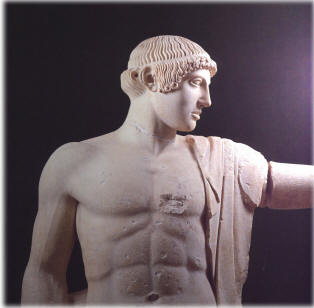
an invisible troupe is heard passing
with exquisite music, with shouts
do not mourn in vain your fortune failing you now,
your works that have failed you, the plans of your life
that have all turned out to be illusions
approach the window with firm step,
and listen with emotion, but not
with the entreaties and complaints of the coward,
as a last enjoyment listen to the sounds,
the exquisite instruments of the mystical troupe,
and bid her farewell, the Alexandria you are losing.
The God Forsakes
Anthony
Constantine Cavafy
THE GAY UPPER WEST SIDE
The venerable old Candlelight changed hands and
became the Candle. Its new owner, Robert Ader, and his lover, Lonnie, gave it
a major makeover in order to compete with all the competition that had sprouted
up in the neighborhood since the mid-Seventies. They covered its huge window
with barn siding, raised the ceiling and knocked out the back wall of the old
bar to make a much larger space; and then, painted the place black inside,
installed the obligatory pool table, opened a downstairs room for sex and pumped out high decibel
dance music on speakers placed throughout the bar no one would have known,
once inside, that they were not at the junction of Christopher and West
Streets.
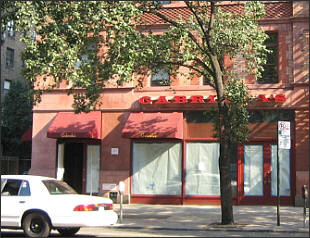 But
the best place in my estimation was the Boot Hill, which of all the neighborhood
gay bars was the dreariest looking, as its initial on-the-cheap, barn siding
renovation of the early Seventies was pretty worn by now, inside and out. It
may be that the tired appearance of the place gave its contrived look some
authenticity. The atmosphere was definitely unpretentious and friendly.
But
the best place in my estimation was the Boot Hill, which of all the neighborhood
gay bars was the dreariest looking, as its initial on-the-cheap, barn siding
renovation of the early Seventies was pretty worn by now, inside and out. It
may be that the tired appearance of the place gave its contrived look some
authenticity. The atmosphere was definitely unpretentious and friendly.
(right) Former site of Boot Hill bar.
The number of patrons in both
the Boot and the Candle was large enough that the level of cigarette smoke was
often intolerable. Finally, both bars had to install high power exhaust fans.
In the old Upper
West Side style, the Boot was very much a place where many groups of friends met
regularly and hung out. One result of having a returning neighborhood clientele,
though, was that the crowd was very sexually "incestuous" as well.
However, I appreciated it as a place to meet people as much as anything. I
can remember after my enforced classical music education while staying out of
bars for most of my first year in AA. I went into the Boot one
night, after just hearing something on WNCN, the classical station, that had
knocked my socks off. I burbled about it to John H. a guy whom I knew only
slightly, and rather than beginning to snore he picked up on my enthusiasm.
It turned out that he staged Baroque operas as part of his livelihood!
something I hadn't a clue about before and we became good friends as time went
on. Another time, when I was talking to John or someone about some music,
a guy standing nearby joined in his name was Gino, and we later had a
romantic/sexual relationship. Granted, it was a gay bar and not a meeting
of the Great Books and Music Club, but I had many long evenings of great
conversation and met interesting people, in addition to the bar chat and the
fucking.
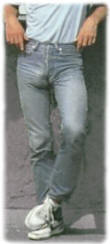 And I know other people had a similar experience at the Boot.
And I know other people had a similar experience at the Boot.
Grass was openly and casually smoked there, and coke
snorting (by a very few) was ignored, as long as you at least faced away from
the crowd.
The music tapes were superb, a mix of dance
music and soul, created by Ed Skala, one of the bartenders.
It
was a bit unusual, perhaps, that a bar which was quite small and attracted
groups of neighborhood friends also had the reputation for being a good cruising
bar. A friend suggested it was the shape and size of the space: from anyplace
in the bar the entire room and all the customers was visible. According to
his theory, being able to stand in one spot and cruise multiple potential tricks
made the Boot a cruising magnet.
My theory (ok, call me shallow) was that a place where you could
smoke grass, snort coke, listen to fabulous tapes and get laid meant that the
room could have been pear-shaped and guys would have still come. And the
proximity of the Candle a couple of doors away, and Wildwood around the corner,
had to have been a plus. Whatever the reason, despite its obvious function as a
local hangout, the Boot acquired something of a reputation as a cruising bar;
and this brought in a steady trickle of curious non-neighborhood people who
were eagerly snapped up and as a consequence, I presume, confirmed the rumor as
truth.
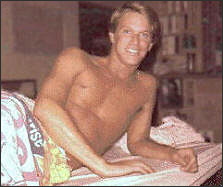 Gay porn star Casey Donovan,
whom I found to be a very friendly and down-to-earth guy, was an occasional
customer, as was another XXX film star, an older "rougher" looking type whose
name I can't recall now.
Gay porn star Casey Donovan,
whom I found to be a very friendly and down-to-earth guy, was an occasional
customer, as was another XXX film star, an older "rougher" looking type whose
name I can't recall now.
Casey
Donovan (Cal Culver)
Perhaps sightings of these guys ratcheted up the
bar's reputation a bit too. But I don't think guys went to Boot Hill expecting to find a
porn star, or even a reasonable facsimile, any more than they expected the guy
in cowboy boots and faded denim to have a horse tied to a parking meter. Maybe
down at the Eagle or the Spike in Chelsea.... But in the Upper West Side bars
there was, I think, still enough of the old, unaffected sexual atmosphere to
provide its own special draw. The guys were cruising for sex (even if that
might sometimes mean a particular sex act) rather than looking to be transported into a
biker, cowboy, etc. fantasy. The Village People had surfaced in '77, with
their members costumed as a leatherman, cowboy, Indian, cop, whatever, and the
people I knew enjoyed 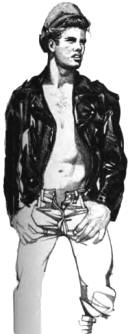 their take-offs of extreme costume fantasies and the
tongue-in-cheek lyrics of their songs. Once in awhile a guy or group of guys
would show up at the Boot in major fantasy costuming and looking very serious
about it; they would instantly get labeled as "the Village People."
However, these observation were humorous, not nasty.
their take-offs of extreme costume fantasies and the
tongue-in-cheek lyrics of their songs. Once in awhile a guy or group of guys
would show up at the Boot in major fantasy costuming and looking very serious
about it; they would instantly get labeled as "the Village People."
However, these observation were humorous, not nasty.
(And speaking of the Village
People, when their song YMCA became popular early in '79, I was really
pleased. I remembered 1960 and the security at Sloane House Y sneaking around
listening at doors, and the West Side Y becoming so dicty about gay men, and
I was happily certain that the YMCA organization must have shit in its pants
when it became aware of the outrageous Village People and their song.)
(right) Vintage Harry Bush drawing
The gay Upper West Side of the Sixties and early
Seventies had been a laid-back mixture of ethnicities and income levels, and
despite the "whitening" and increased prosperity of its gay inhabitants,
many bars (as I recall them) had still retained a kind of leveling atmosphere.
There was definitely such a thing as having too much of a costume "act" or being
into too much posing and attitude and racist opinions did not go over well at
all.
What seemed to be valued or at least, was very much in evidence was
something like a "just guys" attitude, and friendliness. A "clubhouse" spirit
survived though certainly more in some bars than others. If a friend went to a bar in another part of town or outside of the
city, and was asked how it was, the answer, "Not friendly," was clearly
understood to mean, not like here. When The Works opened at 80th and Columbus I
remember that at first it was characterized as "not friendly" and even, "like
the East Side." The bartenders were Andrew and Roger, both who had formerly worked at
Wildwood, and Roger especially had been very well-liked, but the attitude of the
customers was judged to be aloof.
The
streets in the West 70's between Columbus and Amsterdam Avenues had a steady traffic
of guys going to and from the bars. The Village by now was duplicated on a
smaller, friendlier scale on the Upper West Side. Seven gay bars were to be
found within a six-block radius, three of them Boot Hill, the Candle and
Wildwood within a block of each other. In addition to blowing grass in the
Boot, it was also used in the Candle and in what had been a game room in
Wildwood. And the Candle was large enough and dark enough that you could get
away with snorting there too.
All public gay life on the Upper
West Side was oriented toward men as far as I know. I never heard of a bar
that catered especially to lesbians, or any restaurants either. Once in a
blue moon in the late Sixties/early Seventies guys had brought women friends
into the Candlelight Lounge, usually at the beginning of the busy part of the
evening and they were gone by eleven or twelve. I rarely saw women in the neighborhood bars after that.
(The Half Breed, however, was run by a lesbian even though it was a men's bar.)
On the even rarer occasions when someone brought a female friend in at the
height of the late night/early morning business hours the hostile vibes from the
customers would have melted a lead shield.
TWO DRAGS, A DOPE AND A DEAD MAN
Drag queens got a mixed reception
in the bars over the
years though I can only recall seeing three "regulars" in a ten-year time span.
In the early Seventies, when the Picadilly was open, it had employed two guys at
various times who were into drag. However, they never tended bar in drag.
One, Tommy/Tina,
used to leave at the end of her shift on weekends, go home to change and make up and then
return to the Pic in drag on the way downtown to her job as a coat check.
My recollection is that her job
 was at a gay bar called the Gilded
Grape, but I'm not sure of it. As a "type" Tommy in drag
suggested someone like your mother's thrice-married and rather "fast"
sister, who dropped in unexpectedly when you were six years old, on her way to take holiday in Vegas
with a married man. Tommy never affected the usual exaggerated showgirl/movie
star/tart costuming and mannerisms that were a standard
part of most gay drag. And, as a result, he was a totally believable woman.
was at a gay bar called the Gilded
Grape, but I'm not sure of it. As a "type" Tommy in drag
suggested someone like your mother's thrice-married and rather "fast"
sister, who dropped in unexpectedly when you were six years old, on her way to take holiday in Vegas
with a married man. Tommy never affected the usual exaggerated showgirl/movie
star/tart costuming and mannerisms that were a standard
part of most gay drag. And, as a result, he was a totally believable woman.
The original Laura Hope
Crews (above right)
He'd sit at the bar as the evening business began to build up, looking rather
like a slightly less attractive Laura Hope Crews, having a quiet drink or chatting with a customer in his
slightly rusty alto voice; guys would
give him a "Hi, Tina" as they came in and an hour or so later he would check his
hat and hair in the mirror, scoop his cigarettes and change into a large handbag
and leave for work. Tommy's presence in drag never caused a ripple in the Picadilly.
The other bartender only showed up in the Pic in drag to
show off her evening gown to her friends on her way
to somewhere else.
About a decade later in the Boot across the street,
history did not repeat itself.
I
walked into the place one Friday night in the early 80's, and there at
center of the bar was Kim Novak - or at least a reasonable lookalike.
Her outfit was from the Marlene Dietrich school of dress, grey
bell-bottom slacks and
an
 off-white tailored thigh-length jacket tied at the waist, plus a satin dress
shirt. She was surrounded by three or four guys from the
heavy-drinking clique that usually sat all night at the corner of the
bar, who were acting for all the world like adoring stage door Johnnies.
"Kim" remained until almost closing time, and was back the following
night. Her presence was the source of a lot of negative comments.
off-white tailored thigh-length jacket tied at the waist, plus a satin dress
shirt. She was surrounded by three or four guys from the
heavy-drinking clique that usually sat all night at the corner of the
bar, who were acting for all the world like adoring stage door Johnnies.
"Kim" remained until almost closing time, and was back the following
night. Her presence was the source of a lot of negative comments.
The real Miss Novak (above)
The same thing occurred
on the next two weekends, and at this point I was sure that the crowd
was thinner than it usually was. And two or three times I saw guys
enter the place, immediately catch sight of her at the center of the bar
and turn around and leave. Henning, one of the friends I used to
meet there, told me that some guys had complained about her presence to
the head bartender, and that he'd said that there was nothing he could
do about it. Given that his lover was a drag queen, I doubt that
he really felt moved to. However, guys continued not only to
complain, but to vote with their feet. One night I went in after
11:00, maybe closer to midnight, and found only six to eight guys there.
Ouch!
My guess is that the
tip jar, and the loss of business to the other neighborhood
bars made the manager's position unsustainable. Word went out:
he had reached an agreement with "Kim" that she would depart on weekend
nights at 11:00 p.m. (or maybe it was midnight), which was when business
began to move toward its peak. The next weekend at the dot of the
appointed time, she pulled on her gloves ever-so sloooooowly, surveyed
the entire room...ever-so sloooooowly, then, pushing her hair back and
raising her head high in the air, she sauntered to the door, looking down
her nose, first to the right and then to the left on her way out.
This slow-motion performance was repeated two or three more evenings. But having gotten what they wanted, the
crowd paid no attention, and I cannot even remember that she ever bothered to
come back after a couple of weeks.
Certainly at least part of the difference between how Tina and "Kim" were treated had
to do with the fact that the latter put on a performance while at the
bar, whereas Tina did not. Kim, with theatrical instinct, stationed
herself in the dead center of the bar directly opposite the entrance
door and at the edge of the light from an overhead pin-spot. From there she held
court for her three or four friends as she constantly posed vampishly
and swept the room with heavy-lidded eyes. It was a rather
small, almost square room and she effectively dominated it with her
routine from the center of the bar.
Had she positioned
herself elsewhere, sitting at the end of the bar where her friends had
usually sat, for example, probably this contest wouldn't have occurred.
However, there wasn't any doubt that she was looking to be on
display; whereas, Tina had only been casually socializing. The Boot was a
bar for gay men. The only "act" that was wanted there were those
of gay male sexuality, and "Kim" by presenting herself as an
under-the-spotlight
female had decided to go head-to-head with
that. It was a no-brainer in an era when political correctness
didn't trump all.
The Bike Stop just off of the west side of Broadway
was owned by a flamboyant neighborhood guy nicknamed the "Emerald
Queen." The reputation of the bar
was that it attracted a crowd of heavy drinkers and effeminate men. My few visits
over the years confirmed that this was pretty much true. However, I did
see customers drop by in complete drag doing their star turns, and
I understood from one of the bartenders I knew that it happened from
time to time with zero problem.
 The
Boot was a relatively small bar, and anyone doing their "star
turn" tended to take over the visual space.
The customers might lean toward a consensus of the eyes on particular men who were
impressively "hot," "sexy," "incredible"...whatever, but guys who
went into fully worked out "posing routine" turned into dead meat. You could definitely
even over-do a good thing.
The
Boot was a relatively small bar, and anyone doing their "star
turn" tended to take over the visual space.
The customers might lean toward a consensus of the eyes on particular men who were
impressively "hot," "sexy," "incredible"...whatever, but guys who
went into fully worked out "posing routine" turned into dead meat. You could definitely
even over-do a good thing.
I remember a fellow
who came into the Boot twice around the same time "Kim" did. He
was a blond guy with a Marlboro Man face and a very impressive
worked-out bod, who lived up on Amsterdam Ave. and 79th near my friend
Chuck's new plant store, Wildflower. Without a doubt he would have
found plenty of admirers if he hadn't decided to advertise the obvious a
little too dramatically. As "Kim" had, he located one of the
pin-spots, this one dead center of the room. Chin up high, chest
out, shoulders and biceps tensed he bathed in its light, and as he drank
his beer, he turned slowly to the right and then slowly back and to
left.....over and over like a mannequin on a turntable. Paul, a
regular who most customers hoped to see get hit by a bus, commented to no one
in particular and everyone in general, "These blonds must have light
sensors in the tops of their heads the way they find those fuckin'
spotlights!" Mr. Wonderful got appreciative looks, of course, but
judging from the smirks, Paul's remark was making the rounds, or perhaps
the comparison was just obvious. In a bar that wasn't bereft of good-looking or self-confident men, this guy should have
gotten chatted up or made
out, but despite the weekend crowd he remained surrounded by empty
space. He appeared a second time - unfortunately with the same act
and got the same results. Like his drag predecessor he
disappeared into the night, never to be seen again.
In all honesty, I'm
sure if the muscular blond had just not been so ridiculous in displaying
himself he would have gotten some eager attention in the bar. But even if the
drag had not chosen to present her act center stage, I'm equally certain
most of the patrons would probably not have wanted her in the bar during the
height of the weekend business hours. Drags weren't wanted any
more than women were, I'd say. However, men returned the favor.
I never knew a guy who visited a lesbian bar, or who expressed an
interest in doing so.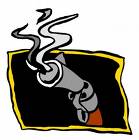
Customer displeasure at
the Boot could take more extreme forms. One evening in the early
Eighties the bartenders had shooed out all but three customers, who were
finishing their drinks, and locked the door. One of the drinkers
was John D., a regular who lived on my block, and the others were two
strangers. One bartender started cashing out, the other was
cleaning up. Without a word the strangers hauled out guns and
blasted away at John. The bartenders hit the floor behind the
bar.....and waited in terror for the shots that would wipe out any
witnesses. But they heard the keys jingling in the door
fortunately they had been left in the lock! and then the door opened
and closed. They looked over the bar, and the strangers had
indeed gone. Poor John was, of course, very dead.
A few small businesses
had been opened near the Boot and the Candle by gay men (and one by a lesbian),
or other not gay-owned had large gay clienteles. The Loft was the largest, a trendy clothing
store that also sold sex paraphernalia, gay greeting cards and rented videos
cruising the other customers or the help was a local sport. The Loft occupied
the space between the Boot and the Candle, and was busy until late on weekend
nights. It also had a branch in Cherry Grove. On the next block up the avenue
was the gay-owned Golden Ass, a small cafι espresso named after the novel by Apuleius (the place played tapes of obscure classical and salon music made by
Yours Truly); Dee Dee's a tiny lunch counter restaurant owned by a Puerto Rican
lesbian; Nishi, owned by a gay Japanese guy and staffed by gay Japanese waiters
who attended the Saint as a group on Sunday nights; Vinylmania, a store which
sold the latest club mixes of dance music and had a huge stock of used records
which made it a goldmine for DJ's and amateur tape makers. Even the funeral
home on the corner of 76th and Amsterdam had two gay employees who hung out
locally. The joke was that you could work, eat, fuck, shop and die and be
buried, without going more than two blocks from that corner for the rest of your
life.
The Upper West Side had
its own gay sex emporium too, Les Hommes on West 80st. It sold the usual run of
magazines and videos, an impressive array of toys, lubricants and dildos, and
had a backroom for on-premises sex as well.
The Cherry restaurant on
Columbus Avenue and the Peninsula on 72nd, a comidas chinas y
criollas place, had steady gay clienteles, but most of the new eating places
across the price scale were regularly patronized by gay men. The new expensive
men's clothing boutiques on Columbus had gay male staff, and
enterprises
from the Sensuous Bean, a coffee emporium, to a going-toward-housewares hardware
store on 72nd, were either gay owned or had gay employees.
In spite of the influx of new gay people and the
busier and more commercial atmosphere of gay life on the Upper West Side, I
found that it remained a very friendly environment. Even if the sophistication
of the men, in both the cultural sense and as regards sexual experience, was
distinctly and aggressively with-it gay New York, the sense of a gay
neighborhood (in a personal belonging sense of that word) remained strong. And contrary to many places
in the Village, most Upper West Side bars maintained a substantial core of
customers for whom their bar was a neighborhood meeting place/informal club and not just a
weekend hang-out.
The same could not be said, I don't think, for
straight life in the neighborhood, where displacement rather than continuity was
the order of the day and not only where the Hispanic and black minorities were
concerned. It was the new Yuppie hot spot, and on Friday and Saturday nights
Columbus Avenue became so "Jerseyated" (overwhelmed by visitors from the other
side of the rivers) that we used to rush to get to the laundry, the drug store,
etc. before seven p.m., in order to avoid the hordes which descended in crowds so
thick you were forced to walk in the street to make any progress.
 Dance music was the sound
from store to store to bar to boutique to restaurant, and with the advent of the
Sony Walkman in the Eighties, any remaining gaps in this soundtrack-for-life
were closed. Soon Everyone, plus Everyone's roommate and Everyone's trick, was
making music tapes for fun (and sometimes for money.) In the beginning the
tracks were simply laid out end-to-end with no gaps, however, inexpensive mixing
equipment arrived before long, and these "amateur" productions became very
professional. Some guys were obsessed with tape making, spending hours and
hours for weeks putting a tape together, and there was a brisk market for the
products of some remarkably talented, but otherwise unknown, tape meisters.
George Malides, a friend of a friend, was one who put together an excellent
series of tapes, and sometime local DJ, Tommy Jenkins, produced a few spectacular ones.
Dance music was the sound
from store to store to bar to boutique to restaurant, and with the advent of the
Sony Walkman in the Eighties, any remaining gaps in this soundtrack-for-life
were closed. Soon Everyone, plus Everyone's roommate and Everyone's trick, was
making music tapes for fun (and sometimes for money.) In the beginning the
tracks were simply laid out end-to-end with no gaps, however, inexpensive mixing
equipment arrived before long, and these "amateur" productions became very
professional. Some guys were obsessed with tape making, spending hours and
hours for weeks putting a tape together, and there was a brisk market for the
products of some remarkably talented, but otherwise unknown, tape meisters.
George Malides, a friend of a friend, was one who put together an excellent
series of tapes, and sometime local DJ, Tommy Jenkins, produced a few spectacular ones.
One night I was standing in
the Boot, really enjoying a new tape by Ed the
bartender that was playing. In my enthusiasm, I turned to the guy next to
me, and said something like, "God, isn't this tape great!" He said, "No
I hate this kind of music." I thought, well, this is what's played
here...why does he come here then? So I asked him why he didn't go to
another bar. He looked at me as if I were a total mental midget. "I
can't! This is what they play everywhere!"
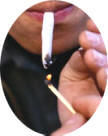
Grass could be had for $75/ounce; cocaine was in much wider
use, and though a single gram purchase could go for $100, anyone who was buying
would buy enough to get the price down to $90 a gram. In
the late Sixties marijuana had sold for about $35/ounce for good stuff, cocaine
had been going for $125/gr. or more. - though at that time the latter wasn't
used by anyone I knew.
1980:
THE SAINT ARRIVES
September of 1980 saw the opening of one of the climactic gay scenes of the
era: The Saint. It was a dance club legendarily built to cater to the crowd that
had patronized Flamingo and went to Fire Island for summer weekends, and it was
colossal in every respect. Flamingo itself was no more.
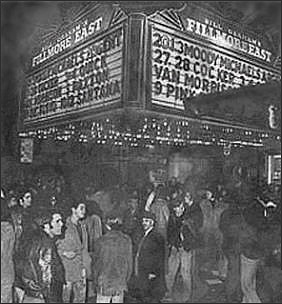 Fillmore
East had been a faded Depression Era movie palace, which for three years in the
Sixties had been the shrine of rock on the East Coast. West Coast rock
impresario, Bill Graham, took over the theater, and beginning in March '68 it
was the East Coast mate to his famous San Francisco Fillmore. As a venue for Bob
Dylan, the Grateful Dead, Janis Joplin, Jefferson Airplane, the Doors and every
other major star and group of the Sixties, it became world famous. I never
attended a concert there, my interest in music had already come down decidedly on the
side of rhythm and blues and soul at this point.
Fillmore
East had been a faded Depression Era movie palace, which for three years in the
Sixties had been the shrine of rock on the East Coast. West Coast rock
impresario, Bill Graham, took over the theater, and beginning in March '68 it
was the East Coast mate to his famous San Francisco Fillmore. As a venue for Bob
Dylan, the Grateful Dead, Janis Joplin, Jefferson Airplane, the Doors and every
other major star and group of the Sixties, it became world famous. I never
attended a concert there, my interest in music had already come down decidedly on the
side of rhythm and blues and soul at this point.
In a
long letter published in the Village Voice in May '71, Graham had announced the
imminent closing of Fillmore East. He concluded his letter:
The rock scene in this country was created by a
need felt by the people, expressed by the musicians, and, I hope, aided to some
degree by the efforts of the Fillmores. But whatever has become of that scene,
wherever it turned into the music industry of festivals, 20,000-seat halls,
miserable production quality, and second-rate promoters - however it went wrong
- please, each of you, stop and think whether or not you allowed it, whether or
not you supported it regardless of how little you received in return.
The last concerts in Fillmore
East were June 25-27, 1971 with shows by the Allman Brothers, J. Geils Band and
Albert King.
The changes in the world of rock
that Graham points to in his letter, its transformation into an expensive,
monster venue music business, may have planted the seeds for the anti-disco
phenomenon of the late Seventies a fierce resentment against the exultant and
inexpensive music world of blacks and gays.
Now,
almost a decade later the old Fillmore East was gutted and fitted out as an
enormous dance club by Bruce Mailman who had already revived the grungy St.
Marks Baths with membership costing several hundred dollars a year, plus an
admission charge each time you attended, and higher prices for special party
nights. The straight disco scene might be expiring, but gay men were still
dancing, and they were doing it, figuratively at least, on one of the graves of
the Sixties-Seventies (straight, white) rock world.
Inside the former Fillmore East had totally vanished and been replaced by a
three-level dance - and sex palace....all it lacked for some was a steam
room. The first floor contained the lobby which opened up onto the coat rooms,
on either side of which were the old marble stairways which went upstairs to the dance
floor, while straight ahead was a bar and lounge. You could also go upstairs
via two industrial type mesh-enclosed spiral stairways from the front of the
lounge.
The
bar was a free-standing one in the center of a raised area and was surrounded by
stair-like banks of seating about 10 feet high covered in carpeting, and at the
rear of this area was the entrance to the locker rooms (three floors rented by
the season to members only.) Also at the rear were two open stairways which went
up to the other end of the dance floor.
The
decor of the lounge area was redone at the end of every summer for the beginning
of a new season.....and was window-display spectacular. One of its last
incarnations was a faux marble extravaganza that would have blown the mind of a
Roman emperor.
Once
upstairs you were actually outside the dance floor. At the rear area you were
on large balconies which overlooked the first floor, and in the front you were
at the back of the former mezzanine where there were johns and some lounging
space. In neither case were you able to see the dance floor though the roar
was like thunder over surf.
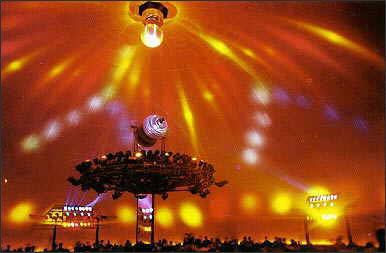 The
dance area itself was circular and covered by a gigantic metal dome 80 feet high, which came
almost all the way down to the floor, and was entered through one of four entrances
which came up under it. You walked up about five stairs and found yourself
inside of what appeared to be an enormous colander. In the center of the dance
floor was a tall mirrored pedestal on top of which was mounted the same type of
projection equipment as is used in planetariums. The interior rim of the
circular dance floor was surrounded by three steps of carpeted bleacher seats,
except where it was overlooked by the DJ's raised booth, which also housed the
lighting technician.
The
dance area itself was circular and covered by a gigantic metal dome 80 feet high, which came
almost all the way down to the floor, and was entered through one of four entrances
which came up under it. You walked up about five stairs and found yourself
inside of what appeared to be an enormous colander. In the center of the dance
floor was a tall mirrored pedestal on top of which was mounted the same type of
projection equipment as is used in planetariums. The interior rim of the
circular dance floor was surrounded by three steps of carpeted bleacher seats,
except where it was overlooked by the DJ's raised booth, which also housed the
lighting technician.
None
of this description really captures anything of what it was like to come up
through the place and arrive at this point.
For
a first-time visitor, or someone blitzed on drugs, your entrance could be
mind-warping. After you ascended the short flight of stairs, suddenly you were
on the dance floor, surrounded by 360 degrees of music and light show and
perhaps more than a thousand sweating, half naked men. You had stepped into a
supernova of energy.
And,
God help you, if you were susceptible to claustrophobia or paranoia.
And on
a level above this was a "lounge area", more or less removed from the incredible
intensity of the music. It very quickly became an area of sexual carrying on.
It
is no exaggeration to say that The Saint was built for "Industrial Strength"
sensation.
The Saint has sustained a reputation for
being the haven for the A-list gay man in the city: body of Apollo,
face of Adonis and carrying a sheaf of platinum credit cards. I cannot
vouch for the sheaf of credit cards, but on a Saturday night or holiday there
would be a not insignificant number of the Built and the Beautiful.
This is certainly the crowd that Bruce Mailman went after first, and they became
as much as part of the club's publicity image as the dome, the sound system or
the light show. However, my fellow B-list gay men were there in multitudes
virtually a necessity to fill that space and keep it financially viable.
The membership was
overwhelmingly white, though there were Hispanics and a
small number of Asians as well. (I rarely saw black guys.) It seemed to consist mainly of men from
their late twenties to late thirties, though you saw younger and older men as
well. Based on some members I knew or knew about, many probably had mid-level white collar jobs;
though the guys I
knew well or met there had low level clerical jobs or were waiters or other non-white
collar workers. So, in fact, the club membership was far from being an exclusive A-Gay
Olympus, though surely a lotta lotta members got off on being part of
that fantasy. We made jokes sometimes about a Pines/Saint Axis, and
I believe without a doubt there were guys whose lives justified that term. But
the Upper West Side guys I knew who were members would not have easily been able to consider a summer in
the Pines as a regular part of their lifestyle including me.
I have no recollection of what a
regular season membership cost, although the legend persists that guys were
offering thousands to purchase a membership before the club opened. None
of the guys
I knew who belonged to The Saint's in its earliest years could have, or would have paid
anything like that. However, I have several receipts for the
rental of a locker, which cost $40.00 per season. Members were also
charged a fee at the door this varied from $12.00 to $20.00, depending upon
the occasion, plus $20.00 for the guest. Charges for the short summer
season were lower than for the rest of the year. Folded around my summer
'86 membership card is a Saint bookkeeper's receipt dated May 11th for $150.00,
which I assume was the cost for that summer. But that was late in the
game.
(Also, remember these are the 1980's.
For comparison the Inflation Calculator web site says $150 in 1986 is equivalent
in purchasing power to $352 in 2020. The Dollar Times site gives the 2019
equivalent of $150 1986 bucks as $344 in 2019. And honestly, my
pocket at least said an audible "Shit, man!" when I forked over that $150 on May
11, 1986.)
The Saint has been characterized
on one web site as "catering predominantly to the gay-lesbian community."
"...predominantly"? This is your basic load of bullshit. It was intended to be and was
a club for gay men. This policy was adhered to very strongly.
At a late point in the game, owner Bruce Mailman did have nights especially for a straight group of
clubbers on a week night, but otherwise straights (even as guests) were never anything but a
tiny
handful of the regular weekend or holiday crowd.
And it was certainly not
a place for anything like "the gay-lesbian community" either. The attendance of women
was not encouraged at all. One night a year there was a specially promoted open
night (can't remember what it was actually called), and on this night women were
welcomed (read "tolerated") otherwise they were as rare as dinosaurs. The first time I went to
this special guest night, a much younger friend, Mark, and
his buddies derisively described it as "Fish City," and skipped going. It
was hardly that. The fact that there were a visible number of women
in the crowd made it a unique night, but even then they were only a very
small part of it. What I noticed more was that the crowd was
smaller than usual, leading me to wonder if a fair number of men shared
Mark's feelings. On the other hand, I wondered too if perhaps there just were not that
many women interested in attending what was known to be a gay men's club.
However, in an era when bars and clubs littered the Manhattan landscape some catering to
one sex or ethnic group or sexual orientation, and others being mixed The
Saint's policy was not remarkable. PC was an abbreviation which just referred to computers.
"DON'T MISTAKE ME FOR
A WHORE"
In 1980 I read Christopher Isherwood's
new book, A Single Man, a novel about the life of a middle age gay man.
The author said it was his favorite from among his fiction works. Drummer
magazine does a big feature on "daddies," plugging into the increasingly
multi-generational social and sex scene among gay men. None too soon
either, I was forty-two.
Me, 1981
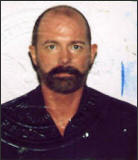 Boy,
I swear in all my years
Boy,
I swear in all my years
I've not felt like this before
If I choose to sleep with you
Don't mistake me for a whore
Let me leave my number on the wall
Call me, honey
Goodness always calls for an encore
Oh, call me, honey
Call Me
from
Dr. Buzzard's
Original
Savannah Band
Goes to Washington
The appearance of leather
as an accepted part of gay clothing fashion in the form of jackets, boots, etc., and as something closer to a lifestyle by a smaller number of
men; and a broader willingness regarding the use "toys", i.e. - dildos, tit
clamps, vibrators and the like, were two of the major changes in the gay scene since
the Sixties. But I think, though I have never seen it written about, one
of the most pronounced changes over previous decades
was a shift in the physical focus of male eroticism.
Put more plainly: it seems to me that in the late Fifties and very early Sixties that cock sucking was the principal
sexual activity, both the active and receptive roles at least judging
from
conversations. Few guys hesitated to admit to taking the receptive role in cock sucking,
but getting screwed in the ass was not something that many men in those years
would speak about off-handedly in a group of gay men. In the era when "butch"
and "femme" had still been used as labels, receptive anal intercourse made you
incontestably femme, no matter how butch you were otherwise.
Also, in my recollection, "fuck" and "fucking" in these years almost always
referred specifically to anal intercourse, and were not general terms for
"having sex."
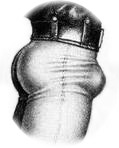 Contrary
to this though,
the artwork of Tom of Finland, for example with his super-hung muscle giants
endowed with huge bubble butts, and eagerly getting screwed surely indicates
that in their fantasies some men in the Fifties and Sixties were not seeing
getting fucked in archetypically feminine terms.
Contrary
to this though,
the artwork of Tom of Finland, for example with his super-hung muscle giants
endowed with huge bubble butts, and eagerly getting screwed surely indicates
that in their fantasies some men in the Fifties and Sixties were not seeing
getting fucked in archetypically feminine terms.
Detail from Tom of Finland drawing
Whatever the
case really was, by the Seventies anal intercourse was as talked about and as
oral sex, and taking the receptive role was somewhat more easily admitted.
Certainly by the mid-Seventies cock and ass as much as cock and mouth were
a focus of gay eroticism.
Taking the receptive role in anal sex seemed not only
to have lost its former stigma, but to have even acquired its own peculiar
macho. (Shades of Tom of Finland.) Being able to "take it" or wanting to "take it all"
whatever "all"
might mean
gave an aggressive, challenging edge to the receptive role.
 Drew Okun
had risen
literally
to fame as Colt Studios' star Al Parker in the 70's, and by
the 80's he was producing films with his own company, Surge Studios. His
handsome face, athletic body and lazy, laid back sensuality made him the one of
the most
recognizable gay porn stars of the era.
Al Parker
Drew Okun
had risen
literally
to fame as Colt Studios' star Al Parker in the 70's, and by
the 80's he was producing films with his own company, Surge Studios. His
handsome face, athletic body and lazy, laid back sensuality made him the one of
the most
recognizable gay porn stars of the era.
Al Parker
The titles of
Christopher Rage's films, Sleaze ('82) and Raunch,
- which my roommate, Tom owned - and Manholes and My Masters
('86) may seem to
tell it all, but don't really. If Joe Gage's films had sometimes seemed to
be on the order of raw porn romances, then Rage switched the focus to Romantic
 porn
his excursions were ironic and florid ventures into territory that had
earlier been explored by Kenneth Anger and John Rechy, as well as Tom of
Finland, Etienne and back to de Sade. Rage now found it in the sexual underground of Manhattan
in the 80's, and the imaginative corners of his own psyche.
porn
his excursions were ironic and florid ventures into territory that had
earlier been explored by Kenneth Anger and John Rechy, as well as Tom of
Finland, Etienne and back to de Sade. Rage now found it in the sexual underground of Manhattan
in the 80's, and the imaginative corners of his own psyche.
Christopher Rage
He was also
a songwriter ( he had once had a song recorded by the classic soul group, the
Spinners), and his use of music in his films had a commentarial twist which was
virtually unique in porn. A former lover of Christopher Rage has been
quoted as saying, that
Rage defined sleaze as "the ability to uncover what a man wanted to do but was
also unwilling to do...and finding the way to get him to do it." And that
was exactly what fascinated my roommate Tom about his films.
Along with an across-the-board rejection by males of the neat and
restrained middle class clothing styles in the Sixties, many gay men
jettisoned some of the traditional gay mannerisms, verbal styles and
conversational topics that had marked them as something on the order of more "in
the know" and "elite" than their straight peers.
A
funny interchange I heard in Boot Hill one night points at this.
Guy
#1: What's that guy like, do you know? (Indicating a nice-looking regular, who
seemed to be a loner.)
Guy #2: Oh, he's nice...but his apartment is full of pictures of dead movie
stars, and all he wants to talk about is dead movie stars...I mean, you know,
who talks about dead movie stars anymore?
I also wonder if the prevalence of
dressing down, the so-called blue collar styles, plus the acceptance (or maybe at the least
just the trying out ) of various hyper-macho styles of personal presentation,
and so on may not have helped to de-feminized getting fucked. Perhaps the wrappings of
the package allow that particular sex role to be re-conceptualized. Guys
talked about sexual roles in terms of "top" and "bottom," but catty remarks
like, "She likes to take it up the ass,"
which were prevalent in the
50' and early 60s
had become rare in my experience.
Where this finally led was to an emphasis on the ass. The terms "ass
work" and "ass play" became common, and what this could encompass in addition to
fucking was rimming, dildos, fist-fucking, and "balling", i.e.
putting cocaine
into the rectum, which dramatically increases and changes the sensitivity inside
the ass. Cock sucking sometimes seemed to be regarded as a foreplay type of sex,
or quickie sex in circumstances that didn't allow for prolonged, heavy action
culminating in anal sex.
By
the turn of the decade the gym-built body was the ideal. And finally it was no
exaggeration to say a lot of guys were trying to build themselves one. A
few of the private gyms in NYC were predominantly gay, the Chelsea Gym for one.
Body display even if you weren't a gym buff - was at the max. The shift was
to less clothes as much to clothes that showed it off. Tank tops, sleeveless
shirts, cut-off jeans, short shorts with wide baggy legs, slashed and ripped
jeans, shirts open to the waist or
my favorite
a jacket with no shirt at all
underneath (summer and winter) and tight jeans
these were the makings of a
"look" at this point.
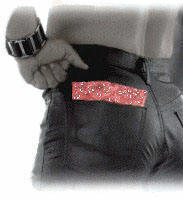
There
was a
time
when our
lusts
were
Like
multicoloured
flags of
no
Particular
country....
Kalama Das,
Convicts
For an advertising-minded minority the rainbow did
not have enough colors to indicate the nuances of sexual pleasure, and bandanas
of every imaginable color peeked from rear pockets
left or right
sometimes
several. A friend of mine once remarked about someone he saw in a bar, "It looks
like he's carrying a goddamned parrot in his back pocket!
 While pierced ears had been somewhat popular for a while, by the early Eighties
they had become more so, and now it was the turn for pierced nipples. Nipples were high priority
eroticism, and a hand sliding up to your chest for "tit play" was a signal that
conversation was about to go seriously braille.
While pierced ears had been somewhat popular for a while, by the early Eighties
they had become more so, and now it was the turn for pierced nipples. Nipples were high priority
eroticism, and a hand sliding up to your chest for "tit play" was a signal that
conversation was about to go seriously braille.
The
"Fuck Buddy" had become if not quite a hallowed institution, a widespread one. For some men the fuck buddy was a guy (or guys) you regularly had sex
with and whose company you enjoyed for an evening of rutting, but with whom you
had little other contact except for sex. These casual, but ongoing sexual
relationships were unremarkable now. For other guys, like myself, these
relationships often developed into something more on the order of
friendship-plus-sex. I enjoyed these relationships and usually had a couple going
at the same time. In some respects, I think fuck buddies became something of
an alternative to having a "lover" during the Seventies and early Eighties.
This may have been due to the fact that these relationships couldn't founder on
extra-sexual expectations and complications, which can encumber and sink more
traditional couple relationships. And the strongest bonds among gay men seemed
to be located in the territory of buddy/comrade/friend.
Also, not infrequently the "tricks" I picked up were people I had slept with
several or many times before, and the distinction between them and a "fuck
buddy" wouldn't always be easy to make.
But one sex partner, whom I've already mentioned, was a guy I'd met in the Picadilly soon after it opened in the early
70's. Howard was a professional pianist, whom I saw once a month for almost
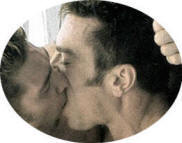 thirteen
years! In his case, the relationship existed nowhere other than the apartment
we had only one formal date in all those years. From the start the
sexual electricity between Howard and me was pretty high voltage, and our
relationship developed without any discussion.
thirteen
years! In his case, the relationship existed nowhere other than the apartment
we had only one formal date in all those years. From the start the
sexual electricity between Howard and me was pretty high voltage, and our
relationship developed without any discussion.
I've been in your body, baby, and it was
paradise.
I've been in your body and it was a carnival ride.
from The
Dislocated Room
Richard Siken
The nuances of pleasure
were explored again and again over many evenings
over many years
and the level of physical
intimacy was unparalleled for me. Through the years the sexual energy
became more powerful rather than less, and while Howard was a very taciturn guy by nature
or perhaps because he was
we achieved a physical intensity and consummation that was almost preternatural.
But over
that length of time the "pillow talk" did gradually turn into something like an extended
conversation.
I recall group conversations
where guys projected growing old with their friends and buddies, not with
lovers. The only men I knew who expressed a wish to have children were a pair
of Jewish lovers. They had their Passover seders at the home of the
married sister of one of them, with her husband and two children, and each year
upon their return they expressed dissatisfaction at the level of her acceptance
of their relationship. And this always seemed to lead to the expressed
wish that they could have children too. There was a third sibling in the
family, another gay brother, slightly older, who was professionally successful
and into leather. He scoffed at their idea: See! we're
almost-het-like-you. He ridiculed both his brother
and sister as being wound up in a ridiculous competition to replicate their
childhood family atmosphere
and then dominate it.
+++ THE PLAGUE YEARS +++
...Would
you agree, then, we won't
find truths, or
any
certainties...
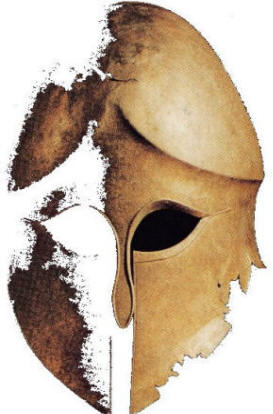
where monsters lift soft
self-conscious voices, and feed us
and feed in us, and coil
and uncoil in our substance,
so that in that they are there
we cannot know them, and that,
daylit, we are the monsters of our night
and somewhere the monsters of our night are...
here...in daylight that our nightnothing
feeds in and feeds, wandering
out of the cavern, a low cry
echoing -- Camacamacamac...
that
we need as we don't need truth...
and ungulfs a Good Night, smiling.
Thomas Kinsella
Good Night
(above) Uncredited image from a Saint mailing
[Note: Ever since I first read Kinsella's poem many decades
ago, I have continued to come back to it again and again. If anyone is
interested in the entire poem this excerpt is taken from, it is in Notes from
the Land of the Dead, Cuala Press (Dublin, Ireland) 1972. The
version which appears in Collected Poems 1956 - 1994 Thomas Kinsella
published by Oxford University Press (Oxford/New York) 1996 is not the same, and
the changes have made it more "polite" and less effective.]
In
August of 1981 the Centers for Disease Control (CDC) of the U.S. government
announced the existence of a fatal disease, whose cause was unknown, which had
infected slightly over 100 gay men in the U.S., most in San Francisco and New
York. The news dropped into my life on a radio newscast sandwiched between
music programs. Earlier, in the beginning of July, the New York Times
had published a short story about a rare cancer, Kaposi's Sarcoma, which had
struck down a number of gay men. The victims showed severe immuno-suppression.
The peculiar name rang a bell - Ah yes, this was the cancer that Ed Burke, the
AA guy
I'd met on the Island the summer of '80, had died from just this past February.
"GAY CANCER" TO AIDS
A rough description of what
later came to be called AIDS: various symptoms and infections in human
beings resulting from the damage caused to the immune system by the HIV
retrovirus. In its advanced stage the disease leaves individuals open to a host
of opportunistic infections, e.g. Kaposi's sarcoma, cytomegalovirus, etc., etc.
Many of these opportunistic infections are relatively harmless, or amenable to
treatment at least, in persons with normal immune systems. In
persons whose immune systems had been compromised by the HIV retrovirus these
opportunistic infections had a catastrophic impact, frequently occurred in a
series of onslaughts and most often were ultimately fatal.
What had been identified and
was being
brought to public attention at this point were those individuals who were
in the end stages of the disease. At this time, though, the cause and progress of
the disease were as yet unknown, nor had it yet been given the name AIDS.
It was briefly nicknamed "gay
cancer," probably because one of the earliest opportunistic
infections to be noticed was itself a cancer.
"Gay
cancer" was the unfortunate name that this syndrome enjoyed for awhile. (One of
the earliest, if not the earliest, opportunistic infection to be noticed was
Kaposi's sarcoma, which is a cancer.) Unfortunate because the government and
the Cancer Society, twenty years and more before, had spent considerable amounts
of money and effort educating the American public about cancer. A major point
that was hammered home, in order to reduce the irrational fear that the disease
provoked, was that cancer was not contagious.
While popper use as a possible cause as smoking for lung cancer
seemed a
reasonable possibility, sex itself did not. Despite the welter of evidence that
began to accumulate
granted much of it sketchy and confusing at first
the
continued use of the term "gay cancer" would furnish some comfort for people like
myself. After all
Cancer is not contagious.
Right?
That
fall, November '81, Bob Cecchi, a friend who lived a few houses down the street
and with whom I spent a great deal of time, began to feel "peculiar." Several
times when we were out he had fainting spells while we were standing in the
Boot. I had to have guys help me get him home and up to his fourth floor
apartment. The diagnosis was presumptive based on his symptoms and an analysis
of something called T-cell counts and other blood factors. He had the new "gay
disease."
1982: THE GAY MEN'S HEALTH CRISIS
Early in the next year Bob went to a meeting held in the apartment of the writer
Larry Kramer in the Village. Seven guys
Arthur Bell, Nathan Fain, Larry
Kramer, Larry Mass, Paul Popham, Paul Rapaport and Edmund White
were the
nucleus of a group which had started meeting at various apartments to try to
figure out how gay men could organize and respond to this health crisis. Some
of the guys there, like Bob, had been diagnosed with GRID (gay-related
immunodeficiency disease), but all were concerned that it's impact seem to
threaten gay men only and the public response was antipathy. (Surprise,
surprise!) They decided
to organize as a formal, tax-exempt entity, and this was the beginning of the
Gay Men's Health Crisis (GMHC), the first
and in its glory days, the largest
volunteer AIDS organization in the United States and the world. Paul Popham
was chosen as the president.
GMHC was offered a couple of rooms for
offices in a rooming house in Chelsea owned by Mel Cheren of West End Records.
A few months later I accompanied Bob to a meeting of GMHC's one and only support
group for people with GRID, held in the old Community Health Project offices on
University Place. There may have been twenty men in the group. (Bob died in
January of 1991. I believe he had outlived all the rest of the group by many years.)
1983: A NIGHT AT THE CIRCUS
The March 14th issue of the New York Native (the
city's only gay paper at the time, I believe) published an article by Larry Kramer
"1,112 and Counting." Many consider it to be the real wake up
call on AIDS. Though some people
like myself
woke up slowly.
On April 30, 1983
18,000 people attended the
Ringling Bros. & Barnum and Bailey Circus performance in Madison Square
garden to raise money for GMHC. Bob Cecchi and I went together. It was truly
thrilling
the most proud I've ever been at a gay event. The
event was covered by television and the newspapers...but not
The New York Times,
whose "liberal" Executive Editor was a thoroughgoing homophobe.
Shortly before
this, one of the original group of founders, Larry Kramer, had had a
characteristically fiery confrontation with the others over the direction of
GMHC, and had dramatically offered his resignation.
His ballistic episodes
were proving too disruptive to the work for the people struggling to keep the
organization on course; he repeatedly played brinksmanship with threats to
quit, and this time his offer was taken up by the board.
In the years after this he would be caustically dismissive of GMHC, and snipe
at Paul Popham, saying that the former Green Beret and decorated VietNam vet had
been afraid that his position with GMHC would out him. 
Paul
Popham
However,
Paul
Popham addressed the crowd that night from the floor of the circus, which
was undoubtedly the first time that most of us had heard him. And Paul
made a point of requesting Kramer, who was in the crowd, to stand up and asked
the crowd to show its appreciation for his efforts in helping found GMHC. These were hardly the actions of someone very worried about the closet
or
of someone holding a grudge.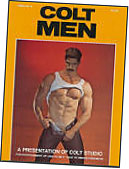
Later
in the decade GMHC cultivated celebrities, but my celebrity sighting for the
evening was Big
Max, a Colt model who had posed for a very sexy poster for the Bull Dog Baths in
S.F. Whew, talk about take your breath away.
Big Max (Sam Pascoe)
Bob went off to a special Circus night at The Saint, while I came back uptown.
I stopped in Boot Hill and met an interesting guy,
David M., and we went back to his place. I saw him several times over the next
few months. He liked to play Survivor's album Eye of the Tiger while we
were having sex, which I could have done without.
It's the eye of the
tiger, it's the thrill of the fight
Risin' up to the challenge of our rival
And the last known survivor stalks his prey in the
night
And he's watchin' us all with the eye of the tiger
The
Eye of the Tiger
Survivor
Grass had
escalated in price to $85.00 an ounce. Cocaine had become quite popular and
easily available.
COME
GOOD DOCTOR, HAVE YOUR SAY
ON THIS TURNING POINT THAT IS TODAY.
George in
a short-sleeved blue-green surgeon's gown
And skullcap rises. As he speaks he'll prowl
Restlessly here, there, back and forth, his owl
Eye fixing the Brothers
LIKE
SOME RARE FULLBLOWN
CULTURE ON A SLIDE!
Robert Merrill
from
Scripts for the Pageant
Tom, my
roommate, who had been a kindergarten teacher when I met him around '74/75 in
Chuck's plant store/hangout on Columbus, and had then quit teaching in 1978 to
become manager of a new gay disco, Les Mouches. About this time he decided to
throw his lot with the woman who was a silent partner in the now straight and
failing disco, and he went to work as a manager in her club, the Fifth Season,
just a block east of where I worked on West 57th Street. It was a straight,
members-only straight sex club that catered to well-heeled businessmen for the most part.
Gay Talese, who had been a
rewrite man on the City Desk when I worked at the Times,wrote a book on the sex industry (Thy Neighbor's
Wife, 1981 ), and the Fifth Season was one of the places he did his field
work.
When I'd met
Tom in the mid-Seventies he had been practically inexperienced
sexually and never used drugs or alcohol he had two siblings who had been
alcoholics and drug addicts, though they had managed to pull their lives
together, and a mother with a drinking problem. But after his stint at Les Mouches he was a daily pot smoker, used "designer drugs" fairly frequently and
had embarked on what was to be a slide into annihilation with cocaine. And now
he was getting into S&M and other kinky sex too.
But at this point he was
managing to keep his focus by concentrating his life on the needs of his former
boyfriend, Robert Pachette, who had been diagnosed with AIDS. One night in August I
took them to The Saint, but after a short while Robert who had been a
professional dancer tired out. We stood there, the three of us, with our arms
around each other, saying nothing, and then the two of them left for a walk. It
turned out that they had spent several hours that night sitting in front of St.
Mark's-in-the-Bowerie church, and it was during this time that Tom made up his
mind that he was going to take care of Robert no matter what happened.
 Miguel
Mendoza, a shy, nice-looking bodybuilder reappeared in the neighborhood after an
absence, and he sublet an apartment in Bob's building. He had what was now
being called GRID, except he had the "gay cancer" too
the disease was still a
mishmash of terms and symptoms and rumors.
Miguel
Mendoza, a shy, nice-looking bodybuilder reappeared in the neighborhood after an
absence, and he sublet an apartment in Bob's building. He had what was now
being called GRID, except he had the "gay cancer" too
the disease was still a
mishmash of terms and symptoms and rumors.
Kaposi's sarcoma
lesions,
they can become extremely large.
Miguel seemed more puzzled than
anything by his condition and used to want to show friends the "spots," which
bloomed with increasing profusion all over his diminishing body. I touched
them with my finger. So, this was "it." They spread onto his face,
and he shrunk more. Miguel's mother had sent him a
religious medal to wear, and Miguel was trying to place his faith and his
hope for a cure in this saint. He disappeared again, to live with a friend in Brooklyn, his brother from
out of town appeared several months later to say he had died.
My friend Bob Cecchi, a former member of EST, was an avid follower of the self-help
movement, and a ready believer in channeled messages and various New Age
theories. Although he worked as a volunteer for Dr. Roger Enlow one of
the early gay doctors to focus on the new disease Bob was characteristically
anxious to do something to help himself, and he told me that he was working with
the Louise Hay tapes. I pulled a blank.
Skip
and Tom K., two lovers from the neighborhood, disappeared. They were "sick". Bob
W. in the next block was "sick".
All
sorts of folklore began to grow concerning the causes and cures of what was now
AIDS. Poppers were the cause. Various peculiar nostrums were going to be the
cure. Ribaviran was the answer. Go to Mexico. Bootleg it into the U.S. I
read Defoe's Journal of a Plague Year. It was actually comforting.
Nothing had changed in the intervening four centuries. It was strangely
reassuring, people were quite the same. When no one knows anything, then
everyone knows everything. When there are no answers, there are no end of
solutions.
SPRING 1984: THE SHIT REALLY HAS HIT THE FAN!
On April 22nd, 1984 Dr. Mason of the CDC was reported as saying: "I
believe we have the cause of AIDS." He was referring to the virus LAV, and
he was basing his opinion on the findings made by French researchers at the
Pasteur Institute who had discovered the virus the previous year. The following
day, April 23th, the United States Health and Human Services Secretary, Margaret
Heckler, announced that Dr. Robert Gallo of the National Cancer Institute had
isolated the virus which caused AIDS. There has continued to be some doubt
about Gallo's claim.
So, without a doubt it was contagious.
And, of course, this knowledge was a big kick in the ass to my own silent
refusal to contemplate the worst. Before this announcement I had muddled along
initially in the belief that it was a cancer and that I might or might not
have it. Now that it was found to be something you could catch, my chances of
having escaped were about as close to zero as they get. Clearly, Billy, the sex
partner who had developed wasting syndrome, etc. even before the initial
announcement of the "gay cancer" must have had AIDS, and several other people
that I had slept with had been diagnosed since. Then one day I ran into David
M., the fellow who had liked to play the Survivor album Eye of the
Tiger while we were having sex. He told me that he had been
diagnosed with ARC (AIDS Related Complex), considered at that time to be the
initial stage of AIDS. So, considering the number of infected people I had
slept with some already deceased, a few not there seemed no
question that I was staring into the eyes of the beast.
Figuring science might make better use of my body before I kicked off than
after, in May I joined a long range AIDS research study that had recently gotten
underway with the Laboratory of Epidemiology of the New York Blood Center. It
was tracking the health of several hundred men (about 800, if I remember
correctly) with detailed questionnaires on sexual and medical history, plus blood
tests.
GOD, THE OASIS
AND THE DESERT
In spring of '84 Henning had surprised me by
asking me to go to mass with him. A straight divorced female friend of his and
he had begun going to a neighborhood parish that seemed to have moved away from its former
conservative Irish-American orientation. I wasn't sure that I really wanted to do this, but
it would mean a lot to Henning, as he was dealing with what was to be his friend Robin's final hospitalization and then, I had to admit (at least to myself)
that the health crisis was haunting me. Robert's death had upset me quite a
bit, and listening to Henning suffer through Robin's illness was difficult.
Maybe this was finally the time, I decided, to probe whether my largely
unexamined assumptions about still being at least a latent believer had any foundations.
However, being by nature a bit bookish
(okay, more than "a bit")
and a lot curious, sittin' 'n lookin' wasn't where it was at. I gradually
became more deeply involved on a personal basis
reading at first, and finally,
after lots of consideration, even participating in the sacraments regularly.
Going on Saturdays with Henning and his friend to the neighborhood church, and
having dinner together afterward sometimes, gave this religious "experiment" a
pleasant social dimension. But later on I also sometimes attended mass on a
weekday at St. Paul's, the church near work, specifically because I wanted to
see what the solitary experience would be like. Eventually a particular mood
began to precipitate: a feeling of discomfort grew in me, and this gradually
increased until it reached the point where I would leave at the completion of
mass with a feeling of deep uneasiness
and ultimately something akin to
frustration or disappointment, perhaps.
The sincerity of the priests I came into
contact with seemed unquestionable, as was the faith of many of those around me.
And yet it seemed like an encampment of anxious of travelers
afraid to leave
and afraid to stay, and constantly and uneasily checking our provisions. The
experience of worship in church began to seem more and more like an oasis, with
its back turned resolutely away from the surrounding desert. I came to feel
that we were ever-involved with an inventory which helped put off a journey
whose direction and purpose was unclear and vaguely threatening.
"THE FATE OF
HIS BONES"
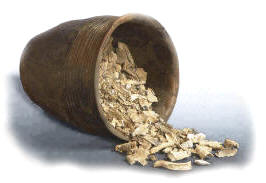
Bronze Age urn burial
from Wales
"But
who knows the fate of his
bones, or how often he is to
be buried?
Who
hath the oracle of his
ashes, or whither they are
to be scattered?
The relicks of many lie like
the ruins of Pompey's, in
all parts of the earth"
Sir Thomas Browne
Urn Burial
Robin, a sly-humored, and rather harmlessly cynical acquaintance from the Boot
disappeared for awhile. Was he sick. He came back. Looked fine. No questions
asked, no information given. He was gone again, and his sleek all-leather
presence was an obvious blank space, and his sometime boyfriend/buddy, a hugely
muscled, super-endowed leather number with a habitual sneer, also vanished. Robin had gone into a coma his best friend (and former lover) Henning told me.
He sat beside his hospital bed every night for fifteen weeks until Robin died.
One evening, shortly before Robin's death, the "boyfriend" appeared not in
leather but in the brown robes of a Franciscan priest (!), gave Robin the last
rites of the Catholic church, left and was never seen uptown by anyone again.
Robin was from Durban, South Africa, and his aged mother asked Henning to have
his body cremated and to scatter the ashes. Henning decided on a spot in
Riverside Park that overlooked the Hudson River on the West Side. He couldn't
bear to keep the ashes in his apartment, so I kept them for him. A few weeks
before the tentative date of the scattering I thought it might be a good idea to
see what cremated ashes looked like as neither of us knew. Well, ashes they
weren't, but more on the order of heavy grit, and fairly large splinters of
bone. (A sloppy job of grinding I was to learn from later experiences.) This
killed any romantic notions of our Robin being borne away as a cloud of dust on
the gentle June breezes!
 We
decided we would scatter him in the sea instead...the sea would have its own
lessons about "scattering".
We
decided we would scatter him in the sea instead...the sea would have its own
lessons about "scattering".
I
took Robin's remains when I went out to the Grove in August '85. His "ashes" were
in a poly bag packed in a box, which I carried down the beach in a plastic sack
to the Pines late in the afternoon, to where Henning was waiting. He carried
them held against his chest the rest of the way to a less trafficked part of the
beach beyond the Pines. We found a spot where three trees showed through a low
spot in the dunes, and decided this would be a good landmark. Henning held Robin's ashes for awhile and cried. Then he handed the container to me, I
opened it and we walked to the water. The day was gloriously sunny and warm.
But there had been a fierce wind for the past day; the seas were heavy and the
surf had cut a steep trench where it broke against the beach.
I held the
container overhead and slid down unsteadily, chest-deep into the surf. A
breaker came rushing forward and covered me completely. I began trying to pour
Robin's remains out in the water in front of me. The sea rushed back out, leaving
me only knee-high in water and the grit blew back on me into my eyes and mouth
and covering my naked body. Another wave covered me then, and while I was
submersed I clawed the rest of Robin out of the box, and let it float out of my
hands. In the next wave I washed the rest of him from my hair and eyes and
rinsed him out of my mouth.
This was Sunday,
August 5, 1984. It
never occurred to me at the time that this might be in the nature of an omen of
how intimate a part of my life AIDS would become.
THE TEST
If you're gonna
bring me something
Bring me, something I can use
But don't you bring me no bad news!
from The Wiz

Shortly after I joined the NY Blood Center
AIDS study we were informed that the recently developed HIV anti-body tests
would be available to participants. The study sponsors were understandably
concerned about the psychological impact that learning of your test results
could have on participants, and they created several options and procedures for
them to choose among.
As far as I was concerned, I'd only be playing games with
myself by hiding from the results. I wanted to be informed of the results flat
out, slam-bam, thank-you-m'am style, and get if over with. Given the fact that I
had been having sex repeatedly with guys in the late Seventies and early Eighties
who had already died of AIDS (and others who were alive but symptomatic), a
positive test result was the only reasonable expectation. My sexual history
gave no reason whatsoever for any other possible outcome. The
on-site manager agreed, and based on the fact that I already seemed to have
accepted that my results would be positive, he asked if I would be willing to do
something. The study was considering a group session where the first batch
of people would be given their results to open if they wished and discuss them,
or perhaps it was going to be a follow-up session after participants had looked
at them received them at home I have forgotten which. He thought
was that given my attitude possibly my reaction and thoughts might be something
on the order of a leveling influence...something on that order. I said
yes.
My blood was taken October 3, 1984.
The test results came back negative. I was
thunderstruck and totally disbelieving. The study manager was likewise. The
anti-body test that had been used was the Elisa, which produced a fair number of
false negatives, and a second test using the Western Blot test was certainly in
order. It too came back negative. Follow-up tests came up negative as well.
Despite the overwhelming odds against me, I had turned out to be negative...for
the moment.
While for quite a few months I had not had partners shoot
their cum in me, nor I in them there was one exception, and an ominous one:
Howard, my steady sex partner of thirteen years.
Early in the year he had complained of having difficulties
with his work because he was always so tired. Then later he told me that the
problem had become so severe, and no doctor had been able to diagnose it, that
he'd taken a trip to the Mayo Clinic. I'm waiting for the shoe to drop, of
course. But he said they had not been able to make a diagnosis either. He told
me he'd been afraid that he had AIDS, but that it had been ruled
out...nevertheless, without any fanfare or discussion he put an end to our
sexual relationship. I never saw him in the bar again either. When I
did run into him in the
street
we lived near each other
he was very friendly, and even came across
with his usual intimate touching. However, his facial appearance had aged badly, and he complained of being hardly able to carry on at work.
Despite the quick eager touches he never suggested "getting together."
We had had sex several times just prior to
my giving the blood sample to be tested. If by any chance he was infected
with HIV, my test result could easily be wrong. I was not inclined to
think that Howard would lie,
his approach to life had always seemed to be almost brutally honest
and tinged
with pessimism...still, the AIDS epidemic was something new and terrifying. I
was ashamed of my doubts. But, I had them. I didn't feel I knew for sure
yet.
"I
wonder what it will be like the day the dancing has to stop? Somewhere someone
will always be dancing, I suppose.
journal entry September 2, 1984
(closing night of The Saint
summer season)

Saint membership cards, locker tag, etc.
"Sisters Are Doin' It for Themselves"
Aretha Franklin & the Eurhythmics
In
the Fall of '84 I investigated Sunday nights at The Saint: "You won't like it!,"
I was warned.
The
reason was that Sunday night was when what my friend Mark said was "serious
dancing" went on. And the guys who ornamented Saturday nights hanging out and
posing were replaced by another special crowd
a core of guys who came and
danced alone. These solo dancers were referred to by Mark and his friends as
the "Serious Dancers." And it did seem on Sunday nights, that these "Serious
Dancers" and the DJs were setting the tone and the pace of the evening in
concert.
Earlier in the year I had bought
my friend Bob Cecchi a summer membership as he didn't have the money to renew
his, and as a favor he took me on the opening night. I enjoyed myself so much
that I dropped by the following week and bought one for myself. Up to this
point I'd only gone to The Saint with company and on Saturday nights.
Sunday night, the eve of the Veterans' Day holiday, I was shuffling around
impatiently waiting for the guys I'd come with to leave the lounge and go
upstairs to the dance floor
always a boring part of the evening for me because
I didn't drink, and I'd stopped using any drugs when I went dancing as I thought
they wore me out rather than heightening the experience. After awhile, in
exasperation, I went upstairs to watch other people dancing and to mumble my
dissatisfaction.
Michael Fierman was playing that night, and doing it even better than usual.
Finally, in a dramatic loss of good sense, I gathered up both left feet and
ventured out onto the middle of the dance floor
alone.
A
monster was born! DJ Michael Fierman made magic just for me and I danced to it
for forever. I was, I felt, literally in heaven
nothing had ever been like
this.
And
nothing ever was afterward, it was a unique experience. For the next three
years the Saint was magical for me. I spent almost every other Sunday night
there, from midnight to eight a.m., being one of the people my friends had
called the "Serious Dancers," and taking my annual leave days one at a time on
the following Mondays to rest up. It seems in my memory that each time, shortly
after I arrived, either
Love
is in the Air
or
Electric
Dreams
would play, and at that point I would be lifted out of myself until morning.
...AND IN THE REAL
WORLD
Late in the year Tom
faced a personal hell. Robert came down with herpes, and Tom told me it
covered part of one cheek and the entire upper part of Robert's face
including both
eyes. Aside from being almost torn apart with anxiety about what would
happen to Robert, Tom also happened to be very squeamish about blood,
disfigurement, etc. Robert came to stay with Tom a couple of days before entering St. Luke's Hospital.
After I came in
from work the first day, I went downstairs to Tom's part of the apartment. Robert was across the room, and he turned his back
toward me. After a few moments he turned and faced me.
The sight of him was horrible.
It was as if he had been hideously burned. His face was covered with livid,
runny sores and his eyes were almost swollen shut. I went across the room and
kissed him, and he gave a great sigh
I think he was probably afraid I might
not touch him.
In the morning Tom called me downstairs.
Robert's eyes needed to be opened and medicated in the morning after swelling
shut during the night, and Tom's hands were shaking so bad, he said, he could not
do it. Would I do it? Later in the afternoon when Tom was at work I helped
Robert again.
I got up a bit early the next
morning, expecting Tom's call again. It didn't come. By an incredible effort
of love and will he had been able to do it.
Robert, struggled on angrily at the hospital. He developed several
additional opportunistic infections. The hospital gave him a yellow face mask,
indicating contagion, to wear when he left the room. He refused to use it. Instead he
put it on the teddy bear he carried with him. Tom was with him every minute of
every day that he was not at work.
In this year the number of
new AIDS cases reached 2,885; there were 1,432 deaths from AIDS that year.
More than a quarter of that number were in NYC, most in the borough of
Manhattan.
1985
We could dance under the moonlight,
hug and kiss all through the night.
Oh baby, tell me, do you wanna dance with me baby?
Do you, do you, do you, do you want to dance?
Do you, do you, do you want to dance?
Do you, do you, do you, do you want to dance with me baby?
Do You
Want to Dance?
Bette Midler
After weeks and weeks in the
hospital Robert died on January 17, 1985 with Tom at his side. Robert's mother
gave his ashes to Tom.
In the summer he took them out to the Island, where they had
spent one summer together working in the Grove. One night he brought them
to the beach, to a place near the Rangers' house at the western end of the
Pines, he told me, and scattered them out on the sand. It was a spot where
Robert had danced in the sand one night on their way back to the Grove.
One early evening that summer Tom took me on a walk down to the west end of the
Pine's boardwalk, and then down onto the beach. He stopped, and said,
"This is the place." He told me then for the first time that after he had
opened the container of Robert's ashes, he had danced on the sand as he spilled
them out. I had to turn away and just stare at the spot for a few moments:
it had been the last dance for Robert the dancer, and the last dance for them
together. We held each other for awhile and then walked on in the
moonlight. Of all the images that pass through my mind of Tom, the one I
never actually saw
him dancing with Robert's ashes
remains the most
sharp-edged, and the saddest. More than thirty years later, when that
image unexpectedly comes into my mind, it still cuts.
1985: AN AIDS
MOMENT
Between 1984 and 1985 the number of new cases of AIDS doubled in that
single year; the deaths did too.
Margaret
"Save-the-Hets" Heckler
On April 15, 1985 Margaret Heckler,
President Reagan's Secretary of Health and Human Services, gave the
keynote address at the First International Conference on AIDS. With
possibly unintentional candor, she articulated the Reagan government's
tardy concern: "We must conquer AIDS before it affects the
heterosexual population."
LEAVING THE OASIS FOR THE DESERT
In the summer of 1985 I took a season's share
in a house on the Island for the first time. In the Pines there were almost no
practicing Catholics (or any sort of active Christians for that matter), and
the heterosexual population seemed as little interested in religion as the gay
men. But I was still involved
though with waning spirit
in the
"investigation" of my religious beliefs. A priest came in by boat to say a
mass early on Sunday morning in a room next to the community health office. The
sand drifted over the wooden walkway beside the building, and although you
could not see the ocean you could hear it beyond the dunes. The building
received the early sun full force, so the doors and windows were left open and
a breeze from the sea blew in steadily. The mass was attended by about fifteen
or a few more people, and the priest seemed a low-keyed and pleasant fellow.
The surroundings were very make-do, of course, and in this setting the little
gathering and the mass itself struck me more than ever like a band of travelers
worrying over preparations on the edge of a trackless territory.
On the second or third Sunday I got up early again and
walked down the lee side of the island to where the mass was held. I waited
outside in a rather stiff wind; the people came along one and two at a time,
holding their sweaters and jackets tightly about them, and hurried into the
room. The sun was well up and shining strongly by the time mass was to begin.
And it came upon me with a deep sense of finality that this was not the place
for me any longer, and that whatever my business had been there it was finished. I walked away, not with doubt but only with a sense of wonder about why I did
not feel doubt. I walked back along the ocean. I passed the walk that led
up to the house and continued beyond the west end of the Pines.
At the point where I saw a clump of three trees waving
above the dunes I sat down. This was the spot where Henning and I had brought
Robin's ashes. I remembered the wind blowing his cremated remains back
onto me, covering my body and getting them into my eyes and mouth. Sitting
in the sand at that spot, I felt as if there were a sudden "in-rushing" from
everywhere around me. Something seemed to physically flow through my body.
And I was left with an unexpected feeling of acceptance about being carried
beyond anything I'd ever expected to experience
about being out in the empty
spaces of life.
Whatever later
significance this event might have had for me, I did not, however, immediately leave the
Island to turn in my Speedos for a hair shirt.
SUMMER IN PARADISE
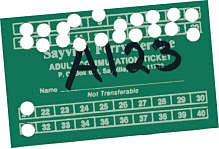 Tom's
boss, had decided late in 1983 that she had to have a house in the Pines (along
with her other homes). And, as I gathered from T., like all of her new
enthusiasms it soon became an obsession to which she harnessed all of her
energies. The piece of property she purchased was a choice lot near the mouth
of the harbor with an unobstructed view of the bay, and within a minutes walk of
the dock, disco, restaurants, etc.
Tom's
boss, had decided late in 1983 that she had to have a house in the Pines (along
with her other homes). And, as I gathered from T., like all of her new
enthusiasms it soon became an obsession to which she harnessed all of her
energies. The piece of property she purchased was a choice lot near the mouth
of the harbor with an unobstructed view of the bay, and within a minutes walk of
the dock, disco, restaurants, etc.
My Fire Island ferry ticket '85
The
existing house was essentially demolished, and erected on its platform was an
architectural fantasy worthy of Malibu...a main floor paved in
one-foot square ceramic tiles (alternating off-white and pale lavender), an all
white interior with all white furniture, a two-story living room, an "entrance
balcony" from the main bedroom which connected to the stairway, and imported art deco inspired
Italian lacquered furniture for each bedroom...impressive even by Pines'
standards.
A
friend of mine, Bill, who worked on Woody Allen's films commented, when I took
him to the house to visit Tom, "No one could really live here, this is
just stage set for production numbers!"
S
trangely, it was
Tom rather than his boss who may have gotten the most use out
of the house. She was an energetic, frequently restless, woman
who almost as
soon as she would arrive by sea plane was on the phone to elsewhere, and making
plans about when she would leave. Tom, however, she began to have in almost
constant residence there, busy supervising repairs, installing enhancements, and
rushing the cleaning and flower arrangements for the chatelaine who vanished
almost as soon as she arrived.
She
was something of a mystery in the Pines, the object of ridicule and gossip, yet
the dispenser of longed-after invitations and the giver of one huge lavishly
costly party a season. I only spent time with her on a couple of visits, and my
impression was that while she might have been a bit over-the-top, more than
anything she was pulling a leg with her role in the Pines. In public she could
be an outrageously and expensively dressed woman in the most frightful costumes
that trendy designers conjured up, but in private she was a funny, unpretentious
person with a big generous streak in her makeup.
Tom
quietly took advantage of the position he found himself in living in this grand, unwinterized movie set. He wrapped himself in a bit of her notorious mystery,
drifting in and out of the social and commercial life of the Pines as the
real-life dispenser of his boss's patronage and proof that she was not after all
a mirage.
The
lot was surrounded by a tidy high wooden fence, which kept the lower floor of
the house screened from the boardwalk. The main entrance was a pair of plain
doors set into an inward curve of the fence. Once through the doors, a visitor
was on a small walkway hanging above a beautifully manicured shade garden about
ten feet below, and you walked across this to a two-story glass wall with double
sliding doors, through which you looked down a long entrance-way, which
descended to the living room area at the back of the house
and even from this
distance you saw out the two-story glass wall at the far end of the house,
across the deck and pool and miles across the bay to the pale line of the shore
of Long Island. Great architectural design theatre!
The
captains of the ferries which brought people from Sayville to the harbor at the
Pines told Tom that they now used the house as their navigational guide to the
harbor on all but the foggiest nights, as it was more visible than the nautical
lights. With a two-story high facade of glass, white siding and mirrored
panels, and perched at the edge of the bay
no doubt about it.
Having pinched a lot of pennies the previous winter, I had taken a share in a
house a considerably humbler abode than this. Most of the guys I hadn't known
before, but I got fixed up with them because they'd been summer roommates with
Henning in the past. It was the first time I'd ever had a place on the Island
for an entire season.
 Me, summer '85
Tom was at his boss's house most of the time, and I came out on
Thursday evenings for the weekend, which meant that I often spent Fridays with
Tom, hanging around over there while the house was groomed and prettied for the weekend and
swimming in the pool overlooking Great South Bay. Late in the afternoon I'd
disappear
and if no one showed up, we might come back much later to collect
Tom, if he was in the mood, and go dancing at the Pavilion, the huge warehouse
of a place which had replaced the old fashion beachy-looking Sandpiper. Once in awhile if
I came out on a week night with a friend, we would have dinner at Tom's and then sit around
blowing grass or tooting coke, swimming and talking till the early morning.
While the weather was gorgeous that summer, and the music and dancing great, it
was largely Tom's hospitality in that splendid house which made the summer seem
like a long and lavish movie. It was a glamorous idyll.
Me, summer '85
Tom was at his boss's house most of the time, and I came out on
Thursday evenings for the weekend, which meant that I often spent Fridays with
Tom, hanging around over there while the house was groomed and prettied for the weekend and
swimming in the pool overlooking Great South Bay. Late in the afternoon I'd
disappear
and if no one showed up, we might come back much later to collect
Tom, if he was in the mood, and go dancing at the Pavilion, the huge warehouse
of a place which had replaced the old fashion beachy-looking Sandpiper. Once in awhile if
I came out on a week night with a friend, we would have dinner at Tom's and then sit around
blowing grass or tooting coke, swimming and talking till the early morning.
While the weather was gorgeous that summer, and the music and dancing great, it
was largely Tom's hospitality in that splendid house which made the summer seem
like a long and lavish movie. It was a glamorous idyll.
Tom seemed to be recovering from his deep depression that followed Robert's
death although he had always tended to hide his feelings. The only sign of
trouble in this paradise was that Tom and I began getting out the coke during
the day if I dropped in, and if we sat around at night the use could get heavy.
"LOVE IS FOREVER AS LONG AS IT LASTS."
Vinicius de Moraes
Brazilian composer, poet & diplomat
After not having sex since
receiving my negative HIV test results ten months before, near the end of the
summer I began what might be described in retrospect as a "comfort relationship." His name
was Gino. He was Italian with a kind of "homely" good looks and a sinewy
athletic build, and an engaging charm which covered a restless, prickly streak
and a
discontented inner life. His mood swings, I was to discover, were of Jekyll
and Hyde proportions
especially in the first few months of our relationship.
Bob Cecchi, who knew both of us, and some of my friends, thought that my
patience with these was more stupid and destructive than it was admirable.
It probably was, far more so than I believed at the time; however, I have come
to think that dealing with this negative aspect of a personal relationship may
have kept the bigger, and less easily dealt with fear of AIDS and death from
overwhelming me. Our usual activities revolved around the fact that we
both liked music of all kinds and enjoyed dancing.
The first time we had sex the condom broke.
We had both tested negative, so after that we never bothered but promised to
honest if we ever wanted to trick with someone else. The sex was
as far as
I was concerned
not very satisfying. But holding a man's warm, healthy
body through the night, when it seemed everyone around me was dying was consolation of inestimable value. The relationship lasted for
a little over two
years, and there are good memories from it for which I remain grateful.
In a time of plague it was a
mutually opportunistic relationship, and when it began I wrote in a journal that
I realized that it would certainly not go on to some imagined "forever."
Sometime later Gino said that in safer times it was unlikely that we would have
been involved with each other on a monogamous basis. However, for the time it
lasted there was often pleasant companionship, and something like a safe harbor
as things seemed to be falling apart on all sides in the storm. For me (I
think), our relationship was an attempt to believe the easy happiness of better days
was still possible: it was my final resistance
to confrontation with the encroaching darkness. In the spring of '87 when
I stopped by GMHC to get information on a new client, a
co-worker of Gino's, who was evidently not aware that we had been going together,
mentioned that
Gino had met and slept with guy on a previous vacation. And that
very weekend when he went away, he had gone to stay with him again. Oh...
So
much for promises.
Gino's temperament and
personal problems had already put the stamp of "temporary" on our relationship
from the first, which I understood. But I had trusted him. And I was
really hurt and angry, because it had ended the way it did.
But quite soon I not only faced the
encroaching darkness, I just hurled myself
into it and embraced it like some evil, hateful lover. And from that point
there was nothing left for a relationship with another man.

1985 had been the first summer in more than
twenty-five years of going to the Grove or the Pines
that I had ever had a house on the Island for an entire summer. And of all
those years it was the best in many ways. What I did not
and would not, and could not
have admitted to myself on the last day that I took the ferry back to Sayville
was that the door of a most beautiful time and place was doubtlessly closing, and locking,
behind me.
STRAIGHT AMERICA PUSHES THE PANIC BUTTON
The number of cases of the "gay cancer" diagnosed before
1981 was 100, but the number of new cases recorded in each of the
following years grew at a rate that should have been alarming: '81 339, '82
1,201, '83 3,153, '84 6,368.... The American public was satisfied with
intermittent press reports about faceless groups of "homosexuals" and "AIDS
victims," with their companion "Haitians" and "drug users." The Reagan
administration remained silent. But in April 1985 Health and Human Services
Secretary, Margaret Heckler, let loose her urgent cry:
"We must conquer AIDS before it affects the heterosexual population."
This sounded the official tocsin
for straight America.
 In
July popular movie and television actor, Rock Hudson, admitted that he was dying
of AIDS, and not as a result of liver cancer as his spokesmen had previously
claimed. His gay sexual orientation was still unknown to most straight
Americans.
In
July popular movie and television actor, Rock Hudson, admitted that he was dying
of AIDS, and not as a result of liver cancer as his spokesmen had previously
claimed. His gay sexual orientation was still unknown to most straight
Americans.
(right) Rock Hudson Hudson ill
with AIDS
If rich, famous Rock Hudson can get it...what then? There have been
repeated assertions that his admission of AIDS "put a familiar face" on the
disease...and that this moved the public in a positive direction. That was not
my impression at the time. From mid-summer until Hudson's death in October the
news media served up a stew of gory tales about his decline. As in Poe's tale The Masque of the Red Death, his fate proved that even the rich and famous
could not hide from this plague.
By September of '85, Time
magazine stated in an article about AIDS, "Anxiety over AIDS in some
parts of the U.S. is verging on hysteria." The use of "verging" was bizarre
considering the article itself is entirely about straight hysteria...an opinion
poll indicated that 47% of Americans believed AIDS could be contracted from a
drinking glass, 28% believed AIDS could jump right up their heinies off a toilet
seat. Not surprisingly, tattooing those infected with AIDS, and quarantining
infected people in their homes or in camps were popular ideas. An LA Times
poll this same year found 51% of the respondents favored quarantine for people
with AIDS, 48% thought infected people should have to carry ID cards identifying
them as such, 45% were in favor of testing job applicants for HIV anti-bodies,
15% were in favor of tattooing...Americans were terrified of the possibility of
casual contact with infected persons.
And the gloves were off. It wasn't just "homos" and
"druggies" any more. But Washington had done nothing to
provide the American public with accurate scientifically verified information
about HIV or AIDS. Wild rumors and disinformation abounded, much of it
fomented by Evangelical religious preachers and conservative GOP politicians.
People went nuts about it, and they were vicious.
One child infected with HIV was reported to be enrolled in
the NYC school system. At a school in the borough of Queens more than 90% of
the students did not report when parents organized a boycott, and they held a
raucous meeting in the school, where they were whipped into a furor by local
politicians.
In
New Jersey a child with AIDS-related complex, though not ill, was barred from
school. In Washington a child with AIDS was tutored in a room alone. And in
Kokomo, Indiana 13-year- old Ryan White, a hemophiliac infected with HIV,
was
being tutored at home via a telephone hookup after his school district barred
him from attending school.
old Ryan White, a hemophiliac infected with HIV,
was
being tutored at home via a telephone hookup after his school district barred
him from attending school.
Ryan White
In our Upper West Side neighborhood Roman Catholic
parents refused to send their children to a parochial school when they learned
that a nearby unused convent was to be turned into housing for PWA's the
project was abandoned.
A woman working at a gay and lesbian community center in
California was burned when attacked with acid. Her attackers screamed, "Die,
you AIDS faggots!"
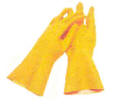 Not
just hospital staff, but policemen and others took to wearing gloves when
dealing with any people they suspected of might have HIV infection in some
places this automatically included any gay men.
Not
just hospital staff, but policemen and others took to wearing gloves when
dealing with any people they suspected of might have HIV infection in some
places this automatically included any gay men.
Some hospital workers refused to bring food
trays into the rooms of patients with AIDS, and left them outside. This
was how Bob Cecchi of GMHC began the Ombudsman's Department at the organization.
He received a call from a PWA at Bellevue Hospital, who complained that he was
going hungry because his food tray was left on the floor outside his room.
Bob worked with the hospital administration to get the situation remedied, and
then began fielding similar complaints that kept coming in. The
Ombudsman's function became one of the most used at GMHC.
 The
need for massive public education, and leadership at a national level was a
crying need, one recognized by Surgeon General, C. Everett Koop was a quixotic man
with a conservative religious views, but totally heads-up about the need for
straightforward public health information. The Reagan administration kept him
muzzled. Even after Reagan appointed a rinky-dink Executive Task Force on AIDS
in 1983, Koop had been excluded from its meetings by his superior, Assistant
Secretary of Health, Edward Brant. Journalists received instructions from
Brandt's office in advance of his press conferences that the Surgeon General
would not answer questions about AIDS, and that he was not to be asked about it.
The
need for massive public education, and leadership at a national level was a
crying need, one recognized by Surgeon General, C. Everett Koop was a quixotic man
with a conservative religious views, but totally heads-up about the need for
straightforward public health information. The Reagan administration kept him
muzzled. Even after Reagan appointed a rinky-dink Executive Task Force on AIDS
in 1983, Koop had been excluded from its meetings by his superior, Assistant
Secretary of Health, Edward Brant. Journalists received instructions from
Brandt's office in advance of his press conferences that the Surgeon General
would not answer questions about AIDS, and that he was not to be asked about it.
The need for public education was desperate. The
government completely abdicated its responsibility, and the media was not proving
effective in filling this gap nor was it always reliable or helpful when it
made the attempt.
Discover magazine, a general science journal printed
an article in late 1985 in which it claimed that the "vulnerable rectum" and the
"fragile penis" would ensure that AIDS would remain a gay disease, while the
"rugged vagina" was going to save heterosexuals. It ignored the fact that
worldwide AIDS was emerging as a predominantly heterosexual problem evidently
the "rugged vagina" had an American patent.
Televangelical preachers were in high gear, stirring up
fear and spreading rumors on television and in print; and anyone who had access to the Internet in these
years knows that
by this time there was hardly an Internet newsgroup, no matter what its putative
focus might be, that didn't find itself bombarded with hate postings and
embroiled in subsequent acrimonious "discussions."
There was a large ruckus over whether leaving the
gay baths open would lead to more infection, or if they could serve as centers
for educating men about safer sex and for dispensing condoms. The debate
raged. New York Governor Cuomo announced he was considering closing them. The
City closed the Saint Mark's Baths, and the New York Times objected,
saying that the baths could probably function as effective AIDS education
resources. However, the baths were closed.
The first week in November, invoking new state rules to
combat the spread of AIDS, New York City closed the Mine Shaft, the surreal sex
palace on Washington Street. In the following year former officer, Richard
Bell and five other men were indicted in February on charges involving the
operation of the two sex clubs in Greenwich Village. Four of the five pleaded
guilty later in the year, the fifth was believed to have fled to Ireland to
escape prosecution, and Bell was convicted of bribery and tax fraud.
GMHC: NEW LEADERSHIP
What a madness and cruel foolishness is this,
that in the time of any great plague
such as are infected, you shut up in
houses, set marks upon them....when as at no time
there is greater need of
fellowship, company, comfort and help than in time of plague?
Paracelsus, 1596

Paul Popham,
the Gay Men's Health Crisis first president and Rodger McFarlane, the first
full-time paid director, aside from their energy and skill
in creating and building the organization, had warm, easy-to-like public
presences, which were crucial, I think, to the organization's success in those
early years. To the gay men of New York they had been gay men working for gay
men first, and only grew into public figures over time.
Rodger McFarlane
Paul resigned in 1985, having been seriously weakened by
Kaposi's sarcoma. (He died on May 7, 1987.) Roger McFarlane gave up his post in
the same year. (He continued to be a leader in other gay and AIDS-related
organizations.)
Richard Dunne, who began as a volunteer in 1983 and served
as a member of the Board, became its next executive director. He inherited a
much changed GMHC. It had had 200 clients by the winter of '82/'83 and 650 by
June '84, and when Dunne took over in 1985 that number had grown to 2,500. The
New York Times stated the current national AIDS statistics as 13,332
diagnosed cases and 6,481 deaths since 1981, with about 40 percent of these
being in New York City.
Despite the hard work and deep dedication of the small
salaried staff, supplemented by administrative volunteers (My boyfriend Gino had
been a full-time, unpaid volunteer from early on), and the addition of a large
number of buddy type volunteers in the fall of '85 who provided one-on-one
support to GMHC clients, the organization became stressed like a
ship in a hurricane during the first years of Dunne's directorship.
Richard Dunne had worked for twelve years in the New York
City bureaucracy, and his most recent post had been as Assistant Deputy
Assistant Commissioner for the Human Resources Administration. By virtue
of his past professional experience he was an "organization man." On the one hand, this equipped
him to shape a new GMHC; on the other, it would unfortunately, but probably
inevitably sever GMHC from its roots.
 CATHOLIC
AIDS MOMENTS
CATHOLIC
AIDS MOMENTS
Pope
John Paul II on October 1, 1986 sent Catholic Bishops a
letter On the Pastoral Care of Homosexual Persons. This papal
epistleunforgivablysays:
"But the proper reaction to crimes committed against homosexual
persons should not be to claim that the homosexual condition is not
disordered. When such a claim is made and when homosexual activity
is consequently condoned, or when civil legislation is introduced to
protect behavior to which no one has any conceivable right, neither
the Church nor society at large should be surprised when
irrational
and violent reactions increase." Thus spake the
Pope of Rome, Vicar of Christ.
Detail from a
Study for a Pope, 1954
painted by Francis Bacon
Meanwhile, these were the same years when the sexual
abuse of children and adults by members of the R.C. clergy was running amok and
being covered up by the same bishops and Vatican who were condemning gay
men during the AIDS epidemic.
In
May, 1986, Philadelphia's aging Cardinal John Krol had already told
a reporter that the spread of AIDS was "an act of vengeance
against the sin
of homosexuality."
However, what
he did not mention was that during his episcopate he regularly
shielded priests who were sexually preying on children from the law
and public exposure. And a later grand jury report found that
Krol
"harmed children in parishes and schools by keeping
known abusers in ministry and transferring discovered abusers to
assignments where parents and potential victims are unaware of the
priests' sexual behavior."
New York's Cardinal
O'Connor waged a fierce and relentless campaign against the use of condoms to
prevent HIV infection
even for homosexuals.
And in some cases he failed to criticize and even accommodated the
homophobic and AIDSphobic actions of parishioners.
But this pious gent had his own dirty undies. The Vatican
Papal Nuncio Cacciavillan to the U.S. has written that in 1984,
ahead of a papal visit, he requested O'Connor to investigate
allegations that Archbishop Harrick of Newark, NJ was sexually
preying on seminarians and that this would be potentially scandalous
to the papal visit. O'Connor claimed to have investigated and
returned a verdict of no problem.
But in 1999 this same O'Connor wrote a letter to the then Nuncio
Higuera arguing against the appointment of McCarrick as
Archbishop of Washington referencing the man's sexual harassment of
seminarians! A few years later McCarrick was publically
revealed to have sexually abused numerous minor boys, seminarians
and priests.
Dioceses from Boston to Buffalo and across the country to
Chicago and Los Angeles, and dozens more have now been exposed as
routinely engaging in Cardinal Krol's practice of concealing the
sexual predators among their priests and shuffling their
assignments, which provided them with new opportunities for their
crimes.
Thus, it is quite clear that while same-sex relationships between
adult secular males were sinful according to the Catholic church,
that molestation and sodomizing of minors has been on the other hand
a widespread clerical privilege.
VOLUNTEERING AT GMHC
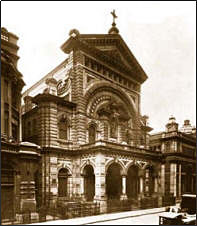
October
2, 1985 I was interviewed and enrolled to participate in their upcoming volunteer
training. Later in the month it took place in two weekend sessions at the
school belonging to the Jesuit parish of St. Francis Xavier in Chelsea.
This church had already had a relationship with gay people as it provided
meeting space for the gay Catholic group Dignity, and allowed Dignity to
celebrate masses in its church. (Later, after a quiet resistance of
several years, the Jesuits were forced by New York Roman Catholic archbishop,
John O'Connor, to close their doors to Dignity.)
St. Francis
Xavier Church, W. 15th St.
By this time GMHC had created a three-branched service of
volunteers to pair with clients who needed them. There were Crisis Intervention Workers (CIW), Care Management
Partners (CMP) and Buddies. The groups were designed to assist PWA
(Persons with AIDS)
clients according to the complexity of their needs, though the distinctions between the first two (CIW and CMP) were virtually
indistinguishable in my experience. All the various types of volunteers were
organized into small teams which met once a month and were led by two volunteer
leaders, and these team leaders met as a group once a month at GMHC with members
of the permanent staff.
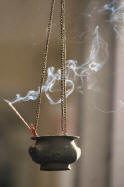
I
had become a Crisis Intervention Worker actually I had "become" nothing of a
sort, but I knew from the training what that was supposed to mean, though I was
in a position similar to that of a putative skydiver who has yet to jump out into
the wild blue yonder. Late in November I approached my first team
meeting feeling like I didn't know whether to shit or go blind. I went down to
an apartment in the East Village. At the door I was greeted by a young woman,
who requested that I remove my shoes, and then shown into a dimly lit couple of
rooms scented with burning sticks of mephitic patchouli incense. The place was
decorated with some pictures or posters, which might have been
interesting, but there was only a bit more light than at the Mineshaft.
While one or two of the honchos in the weekend training
session had seemed to be flirting with the flakier edge of the New Age, most in
contrast
like Diego Lopez, for example were tightly focused and serious. I was
not ready for
what looked like an invitation to a magic carpet ride in the "Mystic East."
Sitting on the floor was agony because of past surgery
there were no chairs and the stench of the cheap Indian incense was rapidly
threatening to be puke-inducing. But just as I was about to say, "Fuck this
weird shit," the team leaders took over the incense was doused, a window was
opened and piles of extra pillows, etc. were requisitioned for we ass-weary
wimps.
There were about ten or twelve members on the team, one or
two straight women and the rest gay men. The team leaders were Lou Katoff, a
psychologist working for an HMO, and Leslie, a social worker completing her
final training. And while I was at first reassured by their pleasantness and
easy-going supervision of the meeting, as things progressed and each team member
spoke of the past month with his client, I began to appreciate the incredible
problems that the leaders and the team dealt with, and my apprehension level
began to rise.
What the fuck did I think that I was doing here!?
[GMHC required that volunteers and staff protect the privacy of its clients. Though it is
thirty-five years later, and all of
those I knew are dead, I have changed their names and omitted enough detail that
I believe their privacy has been respected.]
Fortunately, my first client, Kevin, a young gay man in his
late twenties from a working class Irish-American background, was cut from a
pretty special piece of cloth. He proved to be a tough, gritty and inspiring
guy. More than thirty years later I still consider myself fortunate to have known him and
to have been part of his life, even if only for a short while. And he was
the guy who taught me what it was to be a Crisis Intervention Worker.
Kevin was living with his lover and a roommate who had been
his partner's former lover, and who was now a friend. Our initial meeting on
December 18th seemed a bit formal, and Kevin pretty much treated it
like I was on a job interview and his thoroughness was to prove characteristic
of him. The three guys seemed tightly knit, and very private, and my inclusion
in Kevin's life (or was it their lives?) was not being considered lightly.
Kevin developed KS lesions, but remained in fairly good health for awhile, and
our relationship while not unfriendly, sometimes had a rather distant and dryly
reportorial tone.
He developed a new lesion, this one on his face in
mid-January '86. In April his lover complained to me that Kevin was spending
most of his time alone back at his old studio apartment.
Now the relationship between
Kevin and I quickly began developing into a more personal one. He told me that
he felt that he would die soon and was concerned that his widowed mother and his
lover were not really prepared. A lot of resentment and strain in their
triangular
relationship was coming up, and this finally burst to the surface in
what sounded like a major confrontation. Kevin called me down to his apartment
for an afternoon, and stunned me when he declared to me, "Our (i.e. his and
my) relationship is
primary." It took the rest of the summer for them to rebuild their
relationships, and I had to be very careful to be there for him and support him,
while taking pains never to get myself involved in the trio's difficulties.
Right at this time Kevin got thrown a curve out of left
field. His sister, evidently never a very stable or responsible person, had
abandoned her four fatherless youngsters, and they had been taken by the City.
Kevin spent several months as his strength waned, taking long trips out to
Brooklyn where they were institutionalized and spending a great amount of time
visiting and interviewing potential foster parents. His reaction to
chemotherapy was very bad, but he pushed on. This was his last mission in life.
A couple of days after he had found a suitable home for the youngest boy he
fell into a coma. When I visited him in the hospital the
last week in October I literally bumped into his crying partner and mother as
the burst from his room. He was unconscious. I could only look at
him as so many things I would have wanted to say to Kevin churned inside me.
A few days later he had a series of brain seizures. He
died November 5, 1986.
He was a magnificent guy. My first reaction to his passing
was the usual one of sorrow, but after a couple of weeks I became suddenly very depressed
about his death and it took some time to pull out of it.
1986: AIDS
MOMENTS
Conservative writer
William F. Buckley, a family friend of the Reagans, in a March 18,
1986, New York Times op-ed article, called for mandatory testing
for HIV and said that HIV-positive gay men should have this information
forcibly tattooed on their buttocks (and IV-drug users on their arms.)
To give credit where credit is due, he did not recommend following up
tattooing with gas chambers and
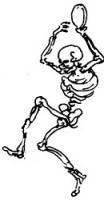 ovens.
ovens.
William "Tattoo
'em"
Buckley
At the 1986 centenary
rededication of the Statue of Liberty the Reagans were sitting next to
French President Francois Mitterand and his wife, Danielle. Bob Hope was
on stage entertaining the all-star audience. In the middle of a series
of one-liners Hope quipped, "I just heard that the Statue of Liberty has
AIDS, but she doesn't know if she got it from the mouth of the Hudson or
the Staten Island Fairy." As the television camera panned the audience,
the Mitterands looked shocked. The Reagans were laughing.
This is illustrative
of the outwardly affable Reagan's emotional remoteness, as attested
to by his children in later years. Reagan's gut reaction to
AIDS was reportedly embarrassment, and this resulted in an absence
of presidential leadership in regard to the magnitude of the health
problem, as well as the conservative hate campaign waged against its
victims.
In 1986 there were 17,792
new cases of AIDS; 11,069 deaths.
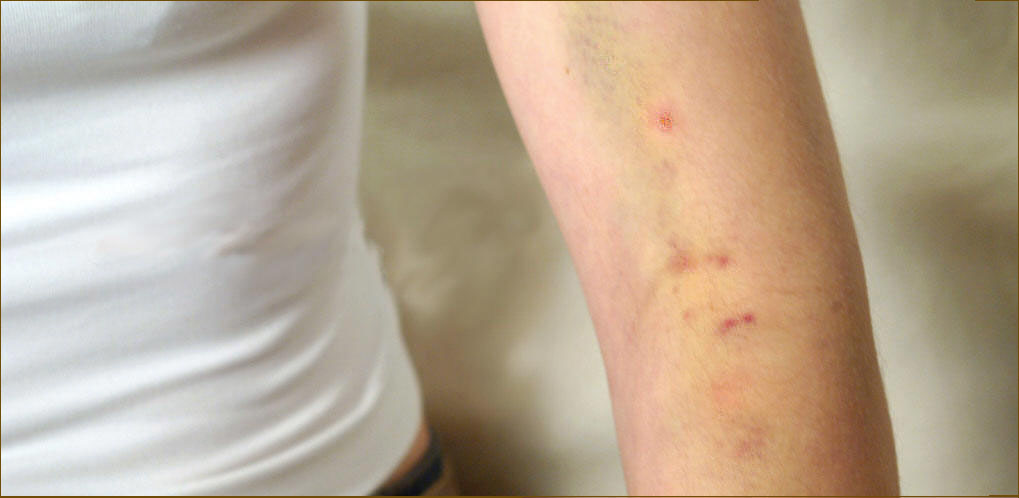
I
was ready for my next client in February '87. Ciaran, another Irish-American
guy, in his thirties and straight, and he was a rollercoaster ride that was over
before it had hardly begun. Ciaran was a heroin addict enrolled in a
maintenance program.
Track marks from shooting.
Though he lived in a welfare hotel only a block and
around the corner
from where our offices had been moved to at Lexington and East 24th St., he proved as elusive as a ghost. Visiting the Kenmore
Hotel to look for him scared the shit out of me, and I spent most of my time
trying to track him through his drug program counselor. Suddenly he vanished. Ciaran was found on an inter-city bus headed for the town where his estranged wife
lived actually it was his body that was found, he had died from an overdose.
By March I was already assigned to Ralph a bisexual guy in
his late thirties, who had already had several serious medical problems by the
time I met him. Prior to this he had earned a very precarious living as a food
vendor in the streets. In addition to his problems due to AIDS, he was involved
with a girlfriend, Tawana, who had a crack habit the size of a polar ice cap.
Ralph was living temporarily in the McBurney Y, but got
relocated into a sleazebag hotel on upper Broadway suddenly he was rushed to the
hospital with pneumocystis carinii pneumonia (PCP). He called me one day to come
to Roosevelt and pick him up, the hospital had said he could be released.
He was a total fucking mess, hardly able to stand on his own, gasping for breath and
coughing. Yet the hospital insisted he was ready for release, despite my
pointing out that he was barely able stand and sounded like a sump pump. And Ralph insisted on leaving.
The staff couldn't hustle us out the
door fast enough.
Uptown at the welfare dump, I had to almost literally drag
Ralph down the hall. When I tried to open his door, I couldn't. It budged an
inch, but wouldn't open. Finally, I had to put Ralph on the floor, and throw my
weight against the door again and again before it would open enough for me to
squeeze in. Inside it was a fucking pigpen newspapers, clothes, shopping bags,
take-out food containers, dirty dishes and trash, trash, trash of every
imaginable kind filled the room to a depth so high that the seat of the chair and bed were
literally not visible above it. And that is no exaggeration! A wall-to-wall garbage dump. And a
festival of roaches, naturally.
Ralph dragged himself to the door. He peeked in and said,
"Tawana. She's been using it with her friends." And he
folded back down on
the floor.
 I
got a few large trash bags from the hotel management, and began trying to clean out
the place. When I finally had gotten down to near floor level in just one spot, I
kept hearing the crunch of breaking glass. I carefully picked up the debris I was
standing on and found that I was crushing countless dozens of empty crack vials
beneath my feet. I began counting them. I stopped at one hundred, and there
were more and more. It was hopeless. Ralph crawled in and showed me Tawana's "jewelry
box": a cigar box almost completely full of empty crack vials. If it had
been fucking wampum she could have bought Manhattan island back, even at current
prices. It would have taken two people hours just
to clean out the worst of the debris. A bigger problem: Ralph's breathing was becoming
frighteningly shallow, and he was hardly able to talk. Fucking assholes at
Roosevelt Hospital!
I
got a few large trash bags from the hotel management, and began trying to clean out
the place. When I finally had gotten down to near floor level in just one spot, I
kept hearing the crunch of breaking glass. I carefully picked up the debris I was
standing on and found that I was crushing countless dozens of empty crack vials
beneath my feet. I began counting them. I stopped at one hundred, and there
were more and more. It was hopeless. Ralph crawled in and showed me Tawana's "jewelry
box": a cigar box almost completely full of empty crack vials. If it had
been fucking wampum she could have bought Manhattan island back, even at current
prices. It would have taken two people hours just
to clean out the worst of the debris. A bigger problem: Ralph's breathing was becoming
frighteningly shallow, and he was hardly able to talk. Fucking assholes at
Roosevelt Hospital!
I dragged him back down to the lobby and laid him on a pile of
old carpets heaped in a corner of the lobby while I called Van, one of our new
team leaders. He rushed up, and we took Ralph back to Roosevelt's emergency
unit.
The hospital was adamant that they would not take him
they didn't even want him in their emergency room. The team leader and I argued
and argued, and the staff kept calling in higher and higher up honchos to tell
us to take Ralph the fuck away. Finally, the supervising doctor of the
emergency unit, or maybe she was the acting weekend supervisor of the hospital,
appeared and ordered us to remove Ralph from their premises.
Van and I refused. We said that we would get
out, and sit on
the steps of the emergency unit. If the hospital ejected Ralph we would leave
him wherever he fell on the ground and call the newspapers to come and see him.
And guess what? Roosevelt suddenly decided to keep him
surprise,
surprise! And he was seriously ill for awhile before he was released weeks
later.
Let it sink in: this occurred at what
was considered one of NYC's good hospitals. Their conduct was a medically
ill-considered judgment (if that was the basis for his premature
release), and the conduct of the administration upon the attempt to get him
admitted to their Emergency facility was foul. I do not recall his
insurance situation, perhaps he had exhausted his benefits, so possibly the
motivation was financial. But, in any case, this description is
entirely accurate. Incidents such as this one occurred at other
hospitals and medical facilities, and are an indication of how fear - and in
some cases prejudice and contempt - erupted even in the very places which are
supposed to exist to care for the sick and the dying.
When he got out he had to find another place to live, but
again the lovely Tawana and her crack habit fucked that arrangement up too. And yet
a third time the
same thing happened. He became such a difficult case that a second member of
the team was assigned to him. Ralph lurched from crisis to crisis
propelled by his girlfriend's drug habit, and he was unable to bring himself to
throw her out of his life.
But a crisis came up in my own life that changed things
radically. On April 14, 1987 I had to give up my CIW work on the team.

 1987:
REAGAN'S AIDS MOMENT
1987:
REAGAN'S AIDS MOMENT
36,058 Americans had been diagnosed with AIDS and 20,849 had died before
President Reagan first publicly said the word "AIDS" on May 31, 1987
(near the end of his second term). It was his last-minute
acknowledgement that mainstream Americans were beginning to
become rational about the disease and concerned about those who
had it.
This historic utterance was made at the Third International Conference on AIDS in Washington.
However, he
drew "hissing" from the crowd when he declared, "Final judgment is up to God,"
according to a review of the history of HIV/AIDS policy by the Kaiser Family
Foundation. Reagan was not a practicing religious believer, but this
pious verdict was absolutely necessary in order to appease America's
Religious Right
voters, the Evangelicals and conservative Catholics who might otherwise be quite perturbed that he
even attended this conference.
LAST DANCE
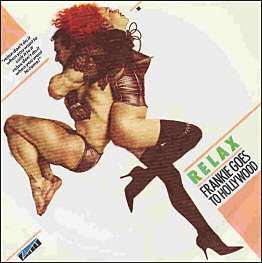
Ashford and Simpson, who had sung so joyfully at the
beginning of the disco era, had more hits in '84 -- Solid, "A
nd
for loves sake, each mistake, ah, you forgave...soon both of us learned to
trust, not run away... it was no time to play. We build it up and build it up
and build it up."
Sam Harris was a very
cute (and closeted) young white guy, but his raw, gutsy voice was that of a male
torch singer and blues belter. He sang Hearts on Fire........"I'm out of
control, my heart's on fire," and left no doubt that he was.
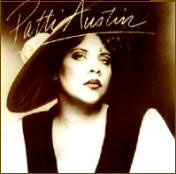 Rhythm
of the Street, by Patti Austin became
almost sacramental for me.
Rhythm
of the Street, by Patti Austin became
almost sacramental for me.
Patti Austin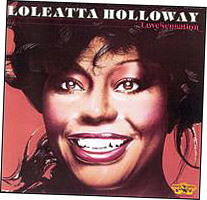
George Michael and Aretha
Franklin made a superb duet, the joyous, Knew You Were Waitin' for Me.
The Pointer Sisters had abandoned their 30s and 40s retro sound and pumped out
super high energy hits like, Jump, I'm So Excited, and Baby, Come and
Get It. Tina Turner, out on her own and free of her husband,
Ike, launched a new career and her first LP contained an entire string of dance
hits
What's Love Got to Do With It, Private Dancer, I Can't Stand the Rain. Sylvester's
former backup singers, now called the Weather Girls were Raining Men.
Loleatta Holloway's Love Sensation album
And the perennial, guaranteed-to-pack-the-floor number
Loleatta Holloway's Love Sensation.
Six o'clock a.m. on a
Monday morning was still the very best dancing time as far as I was concerned.
About then the DJ's would usually slow down the beat considerably, and also play
somewhat offbeat stuff that brought out the Serious Dancers to spin and drift
around the floor, each one floating through his solo dream-dance world...Tina
Turner singing Private Dancer, Simply Red doing Holding Back the Years
(chillingly appropriate) and George Michael (as 1/2 of Wham) singing Careless
Whispers. Or music with a slightly tripping Brazilian beat, and anything
with a long, wailing sax. An exquisitely personal time for each dancer.
For five wonderful years Robbie Leslie, Michael Fierman, Mike Cavallone, Chuck Parsons, Warren Gluck, Mark Thomas, Shaun
Buchanan, Terry Sherman, Wayne Scott and the other DJ's played the music that made the nights there
unforgettable for me...Giorgio Moroder Electric Dreams,
Martin Stevens Love Is In the Air,
Hall & Oates Out of Touch,
Hush My Heart's On Fire, The Communards Never Can Say Goodbye,
Blancmange That's Love That It Is, Sylvester You Make Me Feel,
Lime Your Love, Bonnie Tyler
Holding Out for a Hero....
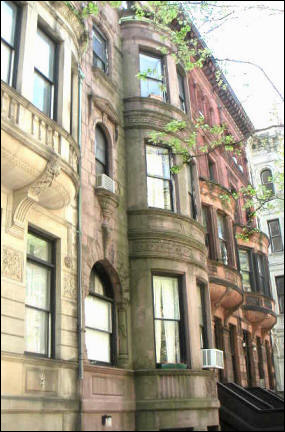 After
a night at The Saint I used to drop Gino off on the East Side just as the city
was waking up for work, and then have the taxi drop me on the West Side, a few
blocks from my apartment. My Levis would be soaked through with sweat, even my
Nikes would be wet through from the dancing, and I'd walk up the streets in the
soft morning light with my shirt off. Everything was quiet and it provided an
opportunity to try to come down from The Saint. It looked as if everything were
at rest and as if life was just as it should be.
After
a night at The Saint I used to drop Gino off on the East Side just as the city
was waking up for work, and then have the taxi drop me on the West Side, a few
blocks from my apartment. My Levis would be soaked through with sweat, even my
Nikes would be wet through from the dancing, and I'd walk up the streets in the
soft morning light with my shirt off. Everything was quiet and it provided an
opportunity to try to come down from The Saint. It looked as if everything were
at rest and as if life was just as it should be.
But when I turned the
corner of my street, I had to forget that within the two blocks between Central
Park West and Amsterdam Avenue there were 15 people sick with AIDS or dying of
it as I walked past their apartments. The Upper West Side had a case rate
second only to that of the Village for awhile.
There was more and more
non-black dance music now, Hi-NRG was at its peak. Frankie Goes to Hollywood
was a favorite "War", "Relax", "Two Tribes". The Bronski Beat album Age
of Consent was a monster hit, every cut was mixed and remixed in every
possible combination and Jimmy Somerville's howling gay soul filled the dome.
Gino started to become
reluctant to go to The Saint. Finally he said it was because of "the holes in
the floor"
he meant the absence of
familiar faces who you'd been used to
seeing there dancing in their favorite spots, even though you never knew them.
The crowds were smaller and the side entrance was used for admission rather
than the large front entrance. Using the large front entrance, someone told me,
attracted the local addicts and street people who were no longer intimidated and
tried to sneak into the club.
After
going to The Saint one night in February '87, Gino refused to ever go again. I
never went back either.
"Pay no attention to the
dark circles
they have always been there
don't mistake me to be broken down
just because I'm on my knees....
I've managed to look good so far
but there's no use pretending....
Born with Teeth
by Cock Robin
By the end of '86 the White Lady (slang term for cocaine) was in
full control of Tom's life, and I had to wonder about my own. Tom had
gotten involved in small scale dealing to finance his use
and, of course, I was involved too.
The real world stopped at our front door.
Although Tom was the one who had the
alcoholism and drug addiction in his family, it was me who finally got it that
we were well down the slippery slope with cocaine. (AA knocking on my
head, no doubt) While Tom had held onto his job, his social life had
diminished to coke and sex
or planning for coke and sex, or
recovering from coke and sex. Fortunately, I was doing considerably
better....but, still, the handwriting was certainly on the wall. Finally,
I took a stand that I wouldn't help him by servicing my friends as customers.
Tom had struggled desperately with
depression after Robert's death, even tried keeping a journal to help himself.
But he had given up
he looked lousy, and he was flying on coke
as often as possible. Without caring for Robert as a ballast he was lost.
An endless series of younger tricks disappeared downstairs with him brought home
after all-night sessions in downtown bars and back rooms. And while I
wasn't dealing for him now, I was still sometimes buying from Tom and was still
around when any impromptu partying took place in the apartment.
At one point it became obvious that Tom no
longer had a job
he had simply walked out without a word to
anyone. I learned this from a desperate message that a co-worker, who was
covering for him, left on his phone recorder. His boss even tried to give him a chance to pull himself together,
but he spurned it, and then, reluctantly, she dropped him. He continued to
try to sell coke, but could barely scrape together enough money to pay his half
of the rent. His existence became furtive. He shut off the
downstairs floor where he lived, he kept it dark and it stunk from being closed
all the time. He stopped changing his sheets, he stopped changing his
clothes, he left uneaten food to rot on his desk...
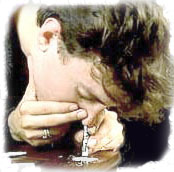 My
wishful thinking died a quick death a last; I finally allowed myself to get the
obvious message. Tom had gone over the edge. I tried to talk to him
about getting help. He looked horrible maybe it
wasn't just coke.
My
wishful thinking died a quick death a last; I finally allowed myself to get the
obvious message. Tom had gone over the edge. I tried to talk to him
about getting help. He looked horrible maybe it
wasn't just coke.
"He opened my nooooose for me!"
Tina Turner (ad lib on a concert album)
But Tom said he
didn't have AIDS. He was totally hostile to my overtures, and from that
point on wouldn't speak to me anymore if he could help it. He was unable
to pay his share of the rent now. I contacted one of his family about his
downward spiral, a sister who had long ago overcome her own addiction problems.
She didn't want to get involved, not until he "bottomed out" and called her for
help. (A cold day in hell would come sooner, knowing Tom. But her
brother, her call.) So, I found myself in the position of either paying
the entire rent in order not to lose the apartment but, thus, in the
process providing Tom with a free ride on his trip to the end of the road.
Even if I had the stomach for it, there was no legal way to toss Tom out: the
apartment was in both our names, and as long as the rent was paid he could
remain in it. The alternative was to give up the place I loved, my home,
and pull out...
Meanwhile, two months before this
situation reached its climax, my best friend, Chuck, had been diagnosed with
AIDS. There was no way I could go to work, plus spend time with Chuck
afterward...and then go "home" to my apartment, to face who knew what the hell
mess. I moved out in March with my clothes and some books and records,
abandoning my furniture and household effects, leaving Tom in possession of the
apartment. I relocated down to a large furnished room near Stuyvesant
Square
the front room of Van, the team leader΄s apartment, which he rented out.
And I used to go up to the Upper West Side to check-in on Chuck after work and
on weekends. After Chuck died I didn't go back to the old neighborhood.
Almost every one I had known was dead, or had moved out.
In July of 1987, four months after I left,
Tom died. He had moved a drug dealer in to share the apartment. Soon he
had dropped contact with everyone in a squalor of boozing and drugs, brought to
a quick end by AIDS-related meningitis. He was the only person I ever knew
personally who dived into drugs and didn't come up again. Given the
history of alcohol and drug abuse in his family it almost seems like this was
his destiny.
Tom had once said that he wanted to have
his ashes scattered where he had put Robert's on Fire Island. But his
brother and sisters had stepped in and taken charge of him just before he died,
and they had their own conventional agenda, which amounted to concealing his
sexual orientation and his AIDS from their mother.
Tom had long ago abandoned the fragmentary
journal of a couple of dozen pages that he began after Robert's death. I
had kept it. A little over a decade later I burned the pages and let the
ashes blow away over the sand into the sea toward the distant Fire Island Pines
where Tom had danced while scattering Robert's cremated remains.
Grass now costs $200 a half
ounce, and cocaine use was decreasing enormously among people I knew.
HOLD ON TO MY LOVE

September 26, 1987 was the last night of the great
Paradise Garage, played
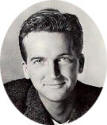 by resident DJ genius Larry Levan.
by resident DJ genius Larry Levan.
Larry Levan
DJ Robbie Leslie, 1986
The
closing of The Saint was three days long, lasting from April 30 until May 2,
1988. Robbie Leslie, possibly the favorite on The Saint's roster of DJ's over
the years was the last to play.
Monday morning Robbie played his trade mark, Hold on to My Love by Jimmy
Ruffin, as the last song. Half way through a balloon slowly rose from one side
of the dome and hovered over the central light tower just under the mirrored
ball. As the song ended and the crowd applauded and cheered, it slowly descended
until Robbie reached out and took it in his hands.
The dome opened and
there was Marlena Shaw. She sang Touch Me in the Morning. And an era of
dancing was over.
It was the very last gasp
of a lifestyle which had been unwilling to die for most of the decade even as
the men who had created it were dying by the thousands.
A
musical epilogue for a time already over.
mail
to: nycnotkansas@gmail.com
NEXT PAGE
Top of Page

 But
the best place in my estimation was the Boot Hill, which of all the neighborhood
gay bars was the dreariest looking, as its initial on-the-cheap, barn siding
renovation of the early Seventies was pretty worn by now, inside and out. It
may be that the tired appearance of the place gave its contrived look some
authenticity. The atmosphere was definitely unpretentious and friendly.
But
the best place in my estimation was the Boot Hill, which of all the neighborhood
gay bars was the dreariest looking, as its initial on-the-cheap, barn siding
renovation of the early Seventies was pretty worn by now, inside and out. It
may be that the tired appearance of the place gave its contrived look some
authenticity. The atmosphere was definitely unpretentious and friendly. And I know other people had a similar experience at the Boot.
And I know other people had a similar experience at the Boot. Gay porn star Casey Donovan,
whom I found to be a very friendly and down-to-earth guy, was an occasional
customer, as was another XXX film star, an older "rougher" looking type whose
name I can't recall now.
Gay porn star Casey Donovan,
whom I found to be a very friendly and down-to-earth guy, was an occasional
customer, as was another XXX film star, an older "rougher" looking type whose
name I can't recall now.

 was at a gay bar called the Gilded
Grape, but I'm not sure of it. As a "type" Tommy in drag
suggested someone like your mother's thrice-married and rather "fast"
sister, who dropped in unexpectedly when you were six years old, on her way to take holiday in Vegas
with a married man. Tommy never affected the usual exaggerated showgirl/movie
star/tart costuming and mannerisms that were a standard
part of most gay drag. And, as a result, he was a totally believable woman.
was at a gay bar called the Gilded
Grape, but I'm not sure of it. As a "type" Tommy in drag
suggested someone like your mother's thrice-married and rather "fast"
sister, who dropped in unexpectedly when you were six years old, on her way to take holiday in Vegas
with a married man. Tommy never affected the usual exaggerated showgirl/movie
star/tart costuming and mannerisms that were a standard
part of most gay drag. And, as a result, he was a totally believable woman.
 off-white tailored thigh-length jacket tied at the waist, plus a satin dress
shirt. She was surrounded by three or four guys from the
heavy-drinking clique that usually sat all night at the corner of the
bar, who were acting for all the world like adoring stage door Johnnies.
"Kim" remained until almost closing time, and was back the following
night. Her presence was the source of a lot of negative comments.
off-white tailored thigh-length jacket tied at the waist, plus a satin dress
shirt. She was surrounded by three or four guys from the
heavy-drinking clique that usually sat all night at the corner of the
bar, who were acting for all the world like adoring stage door Johnnies.
"Kim" remained until almost closing time, and was back the following
night. Her presence was the source of a lot of negative comments. The
Boot was a relatively small bar, and anyone doing their "star
turn" tended to take over the visual space.
The customers might lean toward a consensus of the eyes on particular men who were
impressively "hot," "sexy," "incredible"...whatever, but guys who
went into fully worked out "posing routine" turned into dead meat. You could definitely
even over-do a good thing.
The
Boot was a relatively small bar, and anyone doing their "star
turn" tended to take over the visual space.
The customers might lean toward a consensus of the eyes on particular men who were
impressively "hot," "sexy," "incredible"...whatever, but guys who
went into fully worked out "posing routine" turned into dead meat. You could definitely
even over-do a good thing.


 The
dance area itself was circular and covered by a gigantic metal dome 80 feet high, which came
almost all the way down to the floor, and was entered through one of four entrances
which came up under it. You walked up about five stairs and found yourself
inside of what appeared to be an enormous colander. In the center of the dance
floor was a tall mirrored pedestal on top of which was mounted the same type of
projection equipment as is used in planetariums. The interior rim of the
circular dance floor was surrounded by three steps of carpeted bleacher seats,
except where it was overlooked by the DJ's raised booth, which also housed the
lighting technician.
The
dance area itself was circular and covered by a gigantic metal dome 80 feet high, which came
almost all the way down to the floor, and was entered through one of four entrances
which came up under it. You walked up about five stairs and found yourself
inside of what appeared to be an enormous colander. In the center of the dance
floor was a tall mirrored pedestal on top of which was mounted the same type of
projection equipment as is used in planetariums. The interior rim of the
circular dance floor was surrounded by three steps of carpeted bleacher seats,
except where it was overlooked by the DJ's raised booth, which also housed the
lighting technician.  Boy,
I swear in all my years
Boy,
I swear in all my years Contrary
to this though,
the artwork of Tom of Finland, for example with his super-hung muscle giants
endowed with huge bubble butts, and eagerly getting screwed surely indicates
that in their fantasies some men in the Fifties and Sixties were not seeing
getting fucked in archetypically feminine terms.
Contrary
to this though,
the artwork of Tom of Finland, for example with his super-hung muscle giants
endowed with huge bubble butts, and eagerly getting screwed surely indicates
that in their fantasies some men in the Fifties and Sixties were not seeing
getting fucked in archetypically feminine terms.
 porn
porn

 thirteen
years! In his case, the relationship existed nowhere other than the apartment
we had only one formal date in all those years. From the start the
sexual electricity between Howard and me was pretty high voltage, and our
relationship developed without any discussion.
thirteen
years! In his case, the relationship existed nowhere other than the apartment
we had only one formal date in all those years. From the start the
sexual electricity between Howard and me was pretty high voltage, and our
relationship developed without any discussion.


 Miguel
Mendoza, a shy, nice-looking bodybuilder reappeared in the neighborhood after an
absence, and he sublet an apartment in Bob's building. He had what was now
being called GRID, except he had the "gay cancer" too
Miguel
Mendoza, a shy, nice-looking bodybuilder reappeared in the neighborhood after an
absence, and he sublet an apartment in Bob's building. He had what was now
being called GRID, except he had the "gay cancer" too 


 Tom's
boss, had decided late in 1983 that she had to have a house in the Pines (along
with her other homes). And, as I gathered from T., like all of her new
enthusiasms it soon became an obsession to which she harnessed all of her
energies. The piece of property she purchased was a choice lot near the mouth
of the harbor with an unobstructed view of the bay, and within a minutes walk of
the dock, disco, restaurants, etc.
Tom's
boss, had decided late in 1983 that she had to have a house in the Pines (along
with her other homes). And, as I gathered from T., like all of her new
enthusiasms it soon became an obsession to which she harnessed all of her
energies. The piece of property she purchased was a choice lot near the mouth
of the harbor with an unobstructed view of the bay, and within a minutes walk of
the dock, disco, restaurants, etc.



 Not
just hospital staff, but policemen and others took to wearing gloves when
dealing with any people they suspected of might have HIV infection in some
places this automatically included any gay men.
Not
just hospital staff, but policemen and others took to wearing gloves when
dealing with any people they suspected of might have HIV infection in some
places this automatically included any gay men.  The
need for massive public education, and leadership at a national level was a
crying need, one recognized by Surgeon General, C. Everett Koop was a quixotic man
with a conservative religious views, but totally heads-up about the need for
straightforward public health information. The Reagan administration kept him
muzzled. Even after Reagan appointed a rinky-dink Executive Task Force on AIDS
in 1983, Koop had been excluded from its meetings by his superior, Assistant
Secretary of Health, Edward Brant. Journalists received instructions from
Brandt's office in advance of his press conferences that the Surgeon General
would not answer questions about AIDS, and that he was not to be asked about it.
The
need for massive public education, and leadership at a national level was a
crying need, one recognized by Surgeon General, C. Everett Koop was a quixotic man
with a conservative religious views, but totally heads-up about the need for
straightforward public health information. The Reagan administration kept him
muzzled. Even after Reagan appointed a rinky-dink Executive Task Force on AIDS
in 1983, Koop had been excluded from its meetings by his superior, Assistant
Secretary of Health, Edward Brant. Journalists received instructions from
Brandt's office in advance of his press conferences that the Surgeon General
would not answer questions about AIDS, and that he was not to be asked about it.





 ovens.
ovens.

 I
got a few large trash bags from the hotel management, and began trying to clean out
the place. When I finally had gotten down to near floor level in just one spot, I
kept hearing the crunch of breaking glass. I carefully picked up the debris I was
standing on and found that I was crushing countless dozens of empty crack vials
beneath my feet. I began counting them. I stopped at one hundred, and there
were more and more. It was hopeless. Ralph crawled in and showed me Tawana's "jewelry
box": a cigar box almost completely full of empty crack vials. If it had
been fucking wampum she could have bought Manhattan island back, even at current
prices. It would have taken two people hours just
to clean out the worst of the debris. A bigger problem: Ralph's breathing was becoming
frighteningly shallow, and he was hardly able to talk. Fucking assholes at
Roosevelt Hospital!
I
got a few large trash bags from the hotel management, and began trying to clean out
the place. When I finally had gotten down to near floor level in just one spot, I
kept hearing the crunch of breaking glass. I carefully picked up the debris I was
standing on and found that I was crushing countless dozens of empty crack vials
beneath my feet. I began counting them. I stopped at one hundred, and there
were more and more. It was hopeless. Ralph crawled in and showed me Tawana's "jewelry
box": a cigar box almost completely full of empty crack vials. If it had
been fucking wampum she could have bought Manhattan island back, even at current
prices. It would have taken two people hours just
to clean out the worst of the debris. A bigger problem: Ralph's breathing was becoming
frighteningly shallow, and he was hardly able to talk. Fucking assholes at
Roosevelt Hospital!
 1987:
REAGAN'S AIDS MOMENT
1987:
REAGAN'S AIDS MOMENT
 Rhythm
of the Street
Rhythm
of the Street
 After
a night at The Saint I used to drop Gino off on the East Side just as the city
was waking up for work, and then have the taxi drop me on the West Side, a few
blocks from my apartment. My Levis would be soaked through with sweat, even my
Nikes would be wet through from the dancing, and I'd walk up the streets in the
soft morning light with my shirt off. Everything was quiet and it provided an
opportunity to try to come down from The Saint. It looked as if everything were
at rest and as if life was just as it should be.
After
a night at The Saint I used to drop Gino off on the East Side just as the city
was waking up for work, and then have the taxi drop me on the West Side, a few
blocks from my apartment. My Levis would be soaked through with sweat, even my
Nikes would be wet through from the dancing, and I'd walk up the streets in the
soft morning light with my shirt off. Everything was quiet and it provided an
opportunity to try to come down from The Saint. It looked as if everything were
at rest and as if life was just as it should be. 
 My
wishful thinking died a quick death a last; I finally allowed myself to get the
obvious message. Tom had gone over the edge. I tried to talk to him
about getting help. He looked horrible
My
wishful thinking died a quick death a last; I finally allowed myself to get the
obvious message. Tom had gone over the edge. I tried to talk to him
about getting help. He looked horrible 
